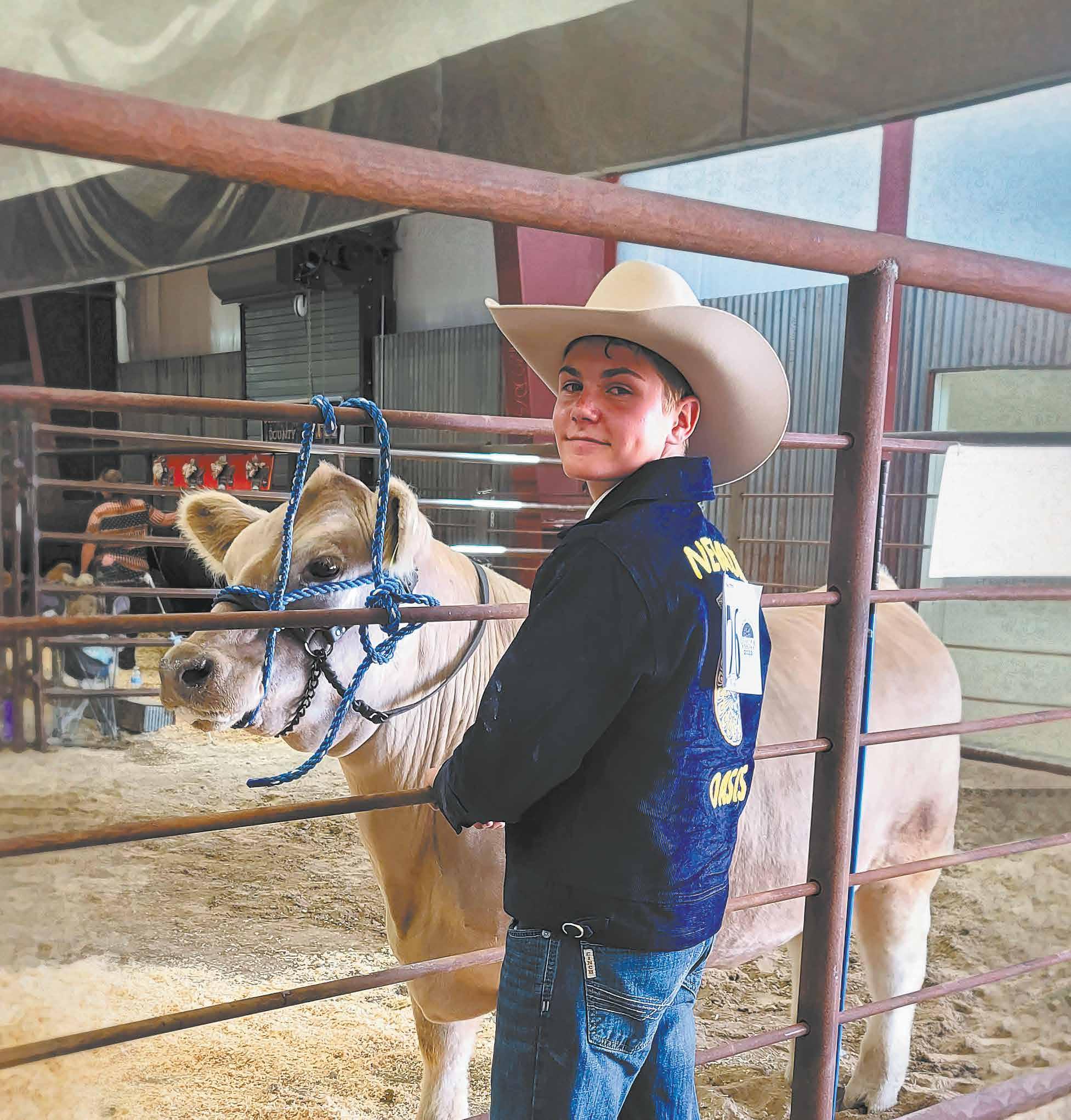
Happy 80 th Birthday, Barbara Hodges!
I'm Flint Lee, one of Barbara's many assistant trainers. She’s she is an awesome teacher who trains great horses. She helped so many of us come up through the ranks of showing. She treats us all like family but like any family there is a favorite, sorry to tell the rest of you, it is me!
Barbara could train anything and had an amazing knack for being able to get the most out of a horse and never asking for more than it was capable of doing. She is just good at what she does but then again she should be she has been practicing for 80 years!
Once when Mom, Dad and Barbara won the team sorting at Elko Fair, when they were called to the winner’s circle Barbara had cleverly named their team Frick, Frack and Fearless!
Whenever we were riding and Barbara's cell would go off (she couldn't see who was calling) she would say "now what son of a bitch wants to talk to me," followed by "Hi this is Barbara" so of course now when she answers my calls I say, "I'm the dumb son of a bitch calling."
Barbara has the greatest words of encouragement for anyone while you are in the show pen, they always made you feel like you were winning the world. Until there was silence, then you knew you screwed up BIG!
My favorite words from Barbara were "Don't worry this is just practice for the next show." Then we got to Reno SBF the first year I was training with her. Before I went in to show my horse I asked her "so what is this show practice for?" "Don't worry about it, show your damn horse.”
I don't think there Is a horse event in this area that Barbara has not impacted from Arabs to paints, roping to barrels, ranch rodeos to halter classes. The name Barbara and Como Chex Hobby has touched them all. I'm proud to call her family and one of my greatest heroes.
A few Barbaraisms: “Your horse was not very nice to you.” "You were so great!" "You need to change leads." "Its ok, two rights are bound to make a left." "Looking good, keep riding!"
Read about Barbara's incredible life on page 33 of this magazine.
Agriculture producers to gather at the Nevada Small Agriculture Conference
Farm Bureau and Extension team up to provide latest information to producers May 5-6 in Las Vegas
Those with smaller agricultural operations, or considering getting into the business, can get a wealth of information on the newest techniques and resources at the Nevada Small Agriculture Conference, May 5-6, at the Santa Fe Station in Las Vegas. The event is being coordinated by the Nevada Farm Bureau and Extension, with assistance from the USDA’s Western Sustainable Agriculture Research and Education Program (WSARE).
The cost to register online by April 25 is $80 (or $55 for Nevada Farm Bureau members). Late registration at the event will be limited, and prices will go up.
May 5 | Morning and afternoon breakout sessions, A lunch session on marketing tools, An evening social and trade show, Dinner with a keynote speaker
May 6 | Morning and afternoon breakout sessions, A lunch session on success stories using WSARE funds, Panel discussion with agriculture leaders in the state
For more info and contact information, visit:
www.farmprogress.com/farm-business/ producers-to-gather-at-small-ag-conference
Ads sent to or built by The Progressive Rancher become property of this magazine. Published 8 times a year. View all issues at www.progressiverancher.com Readership reaches more than 20,000. The views and opinions expressed by writers of articles appearing in this publication are not necessarily those of the editor. Letters of opinion are welcome; submit via email. Advertising rates available upon request. Advertising does not imply editorial endorsement. Liability for errors or omissions in advertisements shall not exceed the cost of the space occupied by the error or omission. Leana Litten Carey, Owner/Editor 2040 Reno Hwy 432 • Fallon, Nevada 89406 (208) 358-2487 • progressiverancher@gmail.com COVER: Rio Segura and his CCJLS Grand Champion highest selling Charolais cross steer from Troy & Nicole Adams of Fallon, Nevada | Photo by Leana Carey IN THIS ISSUE © The Progressive Rancher Magazine. All rights reserved. Owner/Editor/Publisher – Leana Litten Carey progressiverancher@gmail.com Graphic Design/Layout | athena@athenart.com 2 Happy Birthday Barbara Hodges 2 Nevada Small Ag Conference 3 President's Perspective 4 NCA May Roundup 5 Eye on the Outside 6 NBC Checkoff News & Recipe 9 Let's Talk Ag 10 UNR | Nevada Drought Update 11 UNR | Wolf Pack Meats Reopens Production Facility 12 UNR | Best Livestock Practices During Wildfire Smoke Events 13 UNR | Wildfire Awareness Month 14 BLM | Proposed Plan to Guide Management of Public Lands 15 USDA | Snow Report/Forecast 15 Wells FFA Dominates Comp. 17 SRM | Nutritional Value of Antelope Bitterbrush 20 NFB | Land Mgmnt Proposal 21 NFB | Ag In Classroom Event 21 NFB | Cruising Across Nevada 22 PLC | The Roundup 23 NFB | Grassroots Newsletter 24 PLC | Capital Issues 25 Amodei Votes Yes on Limit, Save, Grow Act of 2023 27 NDA | From the Director's Desk 29 NDA | Monitoring WNV 29 Churchill County Learning Advisory Committee Meeting 30 Masto Drafts anti-Mining Law 33 Hodges Inducted Hall of Fame 33 Budd-Fallen Law Office OpEd 34 2023 CCJLSS Photos 35 Tylie Norcutt wins WGYH 36 NDA Disaster Assistance
Cottonwood Ranch Workshops Read the magazine and more articles online at WWW.PROGRESSIVERANCHER.COM
ADDITIONAL ARTICLES AT www.progressiverancher.com Follow us on Facebook!
38
VIEW
The Progressive Rancher www.progressiverancher.com 2 MAY - JUNE 2023
president ' s perspective

"Saving wild horses can save public lands" was a headline that caught my eye. Yes, I thought horses managed to the appropriate levels would save horses from starving/choking to death and save our rangelands from being overgrazed by excess horses. This is a headline I can agree with but sadly, the article, not so much. It was long on feelings and short on facts but the notion that always gets me is the one that "if we run off the cows we can leave the horses alone". While I'm glad that the folks who shovel this load recognize that horses are running out of forage, it boggles my mind that the end game doesn't seem to occur to them.
Here's some rough math: There's something like 2 million livestock AUM's in Nevada and there's something like 42,000 wild horses. Because they graze our rangelands year 'round that's 504,000 AUM's annually the first year. In 5 years when they've doubled in population, they're at a million AUM's, so in 10 years they're at over 2 million. In a decade's time they've

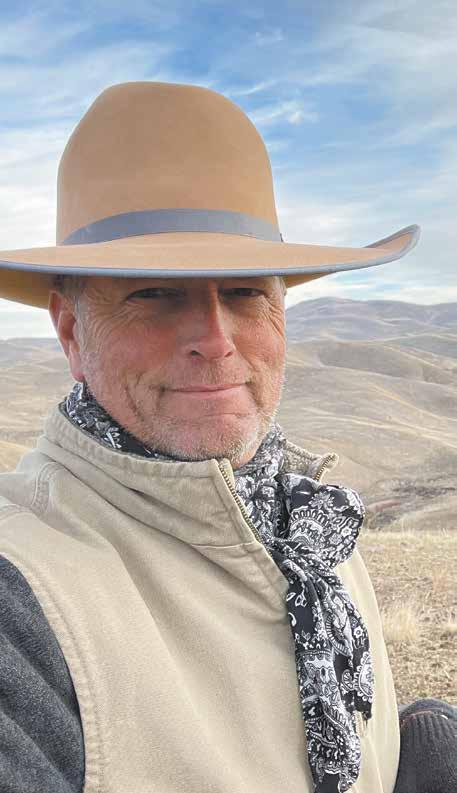
Now we're looking at 3 times as many horses to figure out what to do with. Not to mention what happens to wildlife, local communities, etc… "Cattlemen want horses gathered to make room for more cattle" is a similar position but as you'll recall from last month's rant it's hogwash because the amount of AUM's we have is pretty well set in stone. Fortunately there's a good plan in place to avoid this ecological nightmare. If it keeps getting the funding needed, we'll see horses at appropriate management levels, that is, we'll see them saved. Called "A Path Forward", this plan is supported by real horse advocacy groups and conservation groups, along with cattlemen. Your Association has policy in favor of well-managed horse herds because horses are integral to our way of life. I'm proud of the effort put into this plan.

Two rants in a row, it was a long winter friends, back to sunny days next month.
Jon Griggs

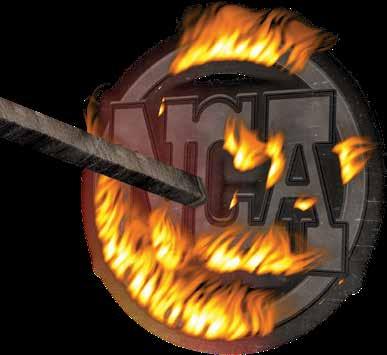
800 - 513 - 4963 • ww w.pinenutlivestocksupply.com Complete selection of animal health products, feed, and equipment for beef, dairy, equine, sheep, goat and small animal. Snyders Pinenut Livestock Supply Fallon: 8 - 5:30 M-F Gardner ville: 8 - 5 M-F The Progressive Rancher www.progressiverancher.com MAY - JUNE 2023 3
by Martin Paris | NCA Executive Director | O: 775-738-9214
NCA May Roundup
Happy May Nevada Cattlemen and Women!
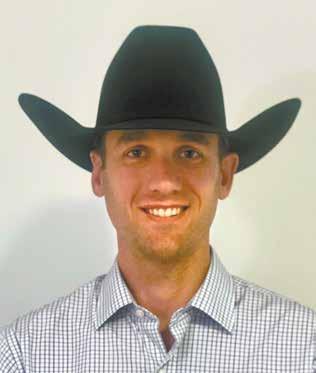
There is a lot going on policy wise lately that has impacts on cattle production. I’ll start with the ongoing Nevada Legislative Session. The Nevada Cattlemen’s Association recently held our Legislative Breakfast in Carson City and had the opportunity to speak with legislators on several different bill that are important to livestock producers. We would like to thank the legislators that made time to stop by and hear what our Association’s priorities are.
Here's a brief summary of where a few bills stand with about a month remaining in the Legislative Session. Assembly Bill 102, which NCA opposed, proposed to ban coyote hunting competitions in Nevada and was not scheduled for a vote and therefore “died”. Assembly Joint Resolution 3 that would have enshrined the right to a clean and healthy environment, pure water, clean air, healthy ecosystems, and a stable climate into Nevada’s Constitution also missed the vote deadline and can be considered dead. NCA supported Assembly Bill 91 which would allow people on public lands to replace their damaged well without the need to file a change in place of use application with the State Engineer, so long as the replacement well is located no more than 300 feet from the original well. This exemption is currently available for well owners on private lands but not on public lands. We also saw Senate Bill 90, which would designate wild horses as the “State Horse” of Nevada, pass through the Nevada Senate and now heads to the Assembly.
At this point in time several bills (both good and bad) that NCA has provided testimony on are continuing their way through the process. NCA is gearing up to respond accordingly as these bills move from the Assembly to the Senate or vice versa for approval.
There’s also a lot to talk about this month on the federal side of things as well. Recently we’ve seen a drug only intended for use in animals, xylazine, showing up in communities across the United States. Xylazine is being mixed together with other illegal drugs to create a concoction sure to give you a visit to emergency room or worse, the morgue. As many of you are aware, xylazine or “Rompun” is an important animal health drug that acts as a sedative and local anesthetic which can be used in procedures
on many different large animals. Due to its recent illegal use in humans, efforts were underway to classify it as a Schedule III drug which would have place severely restrictive regulations on its use and create a liability headache for veterinarians around the country.
However, NCA and other stakeholders were able to work with Senator Cortez-Masto on the now introduced Combating Illicit Xylazine Act. The Act, if passed, would define the appropriate use of xylazine in animals as licit and all human use of the drug as illicit. Transporting or selling xylazine for human use would fall under penalties associated with a Schedule III drug, allowing law enforcement agencies to punish those involved in illegally procuring or using xylazine while maintaining the legitimate use of xylazine for horses, cattle, and other animal species. NCA would like to Senator Cortez-Masto for working with us to find a commonsense solution to the issue that does not punish our industry and veterinarians. We hope for a speedy passage of the bill.
On the federal land management agency front, the Bureau of Land Management is currently proposing a rule that would make significant changes to the agency’s authority under the Federal Land Management Policy Act. Oddly enough it was crafted internally at the highest levels of the agency without input from anyone, including Nevada
BLM personnel responsible for the management of millions of acres in our state. If approved, the rule would clarify that conservation is a “use” equal to all other multiple uses on public lands. The goal of this clarification would be to introduce the concept of conservation leases on public land, described as a way to allow surface disturbing activities or NonGovernmental Organizations to lease landscapes for compensatory mitigation or other restoration activities. While BLM maintains that conservation would not be prioritized over other uses, proof will be in the pudding.

The proposed rule also amends existing Areas of Critical Environmental Concern (ACEC) regulations to “give priority to the designation and protection of ACECs”. The rule would emphasize ACECs as the principal designation for protecting landscape intactness and habitat connectivity.
NCA looks forward to defending livestock grazing as one of the most important conservation tools available and will have the rule on our priority list throughout the duration of the approval process.
This is just a snapshot of some of the work NCA is doing on your behalf. If anyone has any questions, concerns, or input on the above or any other issue please don’t hesitate to reach out to us at nca@ nevadabeef.org or (775) 738-9214.
Nevada Water Solutions LLC Thomas K. Gallagher, PE 775 • 825 • 1653 / FAX 775 • 825 • 1683 333 Flint Street / Reno, NV 89501 tomg@nevadawatersolutions.com Water Rights / Resource Permitting Expertise The Progressive Rancher www.progressiverancher.com 4 MAY - JUNE 2023
Should I be worried..?
If you think about the ranching business right now there is a lot to not be worried about. We had a record winter in the west, so there will be plenty of moisture this upcoming season. However, there was a downside to the winter with a lot of stress visited upon cows and baby calves.

I believe the message that grazing animals for food is a sustainable way to convert sunlight, forage and water into a palatable human food source by utilizing otherwise marginal land is finally being widely acknowledged as one of many solutions to help feed an ever-growing world population. The technology and genetic innovation to help this notion to be more accepted is also a part of the reason to be optimistic.

In the cow-calf sector the early markets are producing budget inflating prices and it looks like the trend will hold through the summer auctions. The supply chain slow downs and backups we experienced during the COVID pandemic are fading memories now and things seem normal again. Finally, there appears to be no slowing of the consumers’ taste for beef.
In fact, demand for beef is very high as we enter the beginning of the grilling season. But there is a decrease in cattle processing and carcass weights which is resulting in lower beef production. This diminishing supply means higher prices at the meat case in grocery stores. This leads me to ask the above question twice- should I, or rather you and I be worried?
Recently I bought four choice filet mignon steaks because we were having some friends over for a barbeque. The price tag was a little over twenty dollars, so it worked out to about five dollars apiece for the steaks. If you think about that, this high quality very tasty meat was less than a combination meal at your favorite fast food burger place. Whereas before thinking about this anecdote I might have worried we were pricing ourselves out of the marketplace, now I am not so sure. I have read pork is not taking over much of beef’s market share and there is evidence poultry is not being invasive either because consumers are bored with the taste of chicken. Thus, if we do not have to be worried about the marketplace, with what do we have to concerns?
This leads to another thing to not be concerned about. Global demand for the beef we produce in this country continues to grow. We are the standard by which the rest of the world measures quality. This can only mean that as long as American beef producers continue on the path we are now seeking to constantly improve our out put we will have markets overseas. This helps with the food security needs of the whole world, not just the United States. Speaking of food security, across the world, but especially here, animal agriculture is one of the solutions for the need to feed a growing population. The term upcycling is becoming more well known. Essentially it means what ruminants do best. By eating things humans can’t- grasses, leaves, crop residue, byproducts like distillers’ grains, and food waste, for example, and by utilizing land that can’t grow crops, the ruminant provides us a highquality protein source that we otherwise would not have. They upcycle these other things to help feed the world.
I have written about this recently but, should we be worried about plant-based meat like products and lab grown meat from animal protein cells? I would say the bloom is off the rose so to speak. Plant based meat substitutes just don’t taste good. Don’t ask me, ask the customers of famous burger joints who tried the product after significant advertising rolling out the choice and declined to come back except to choose their favorite beef burger. This caused the chain to rethink its offering and the menu item went the way of all fake stuff. As for the cell-based lab grown protein the inputs are so great, and the taste isn’t there that these companies are
losing money and not fulfilling the goal of trying to save the planet one burger at a time.
Speaking of which, that planet saving goal is based upon the false premise that animal agriculture is a significant contributor to global climate change and if we just get rid of all those animals the target to reduce the carbon footprint in our atmosphere will be easier to hit. Of course, by now anyone who has read the literature around this topic knows in the United States beef production contributes about 1.5 percent of our carbon dioxide emissions and all of agriculture contributes less than 15 percent around the world. As I wrote above, think of upcycling as a solution, not a contributor to the problem of climate change.
Let’s go back to the initial question. I believe anyone who is involved in production agriculture should always be a little worried. However, discussing the shortened list of topics above and analyzing them on the worry meter, I think I come out more optimistic than pessimistic. I’ll let you come to your own conclusion.
I’ll see you soon
WE INSTALL PIPE JED HEATON (208)430-8789 TYKUS HEATON (208)260-0098 THIRSTYCOWS.COM The Progressive Rancher www.progressiverancher.com MAY - JUNE 2023 5
Nevada Beef Council Attends Annual Meat Conference

NBC staff recently attended the Annual Meat Conference (AMC) on March 6-8 in Dallas, Texas. The Food Marketing Institute (FMI) and North American Meat Institute (NAMI), a contractor to the Beef Checkoff, partner to provide this yearly opportunity for meat professionals to get a pulse on meat retail trends and meat shopper insights. This is the first year since 2020 that it was in-person, and was a great opportunity to reconnect with retailers, suppliers, and colleagues in the meat business.
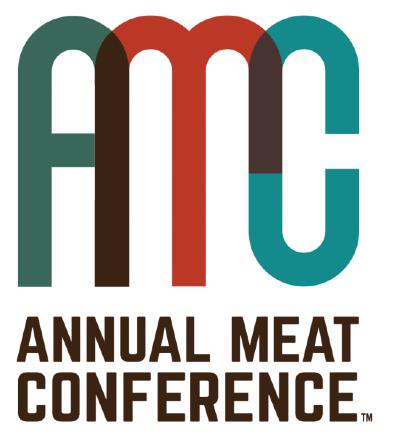
The NBC had a chance to attend insightful presentations, such as the highly sought-after The Power of Meat 2023 presented by 210 Analytics’ Anne-Marie Roerink. Each year, The Power of Meat study combines shopper input with IRI sales results to give valuable insight into today’s consumer purchase decision tree, meat’s role in meal planning and execution, and retail challenges and opportunities.
Some of the other educational sessions, included topics about Case Ready Meat; the 2023 Market Outlook for Meat and Poultry in which Randy Blach, CEO of CattleFax, provided beef market forecasting; and Using Influencer Marketing and Social Media Partnerships which featured the Hardcore Carnivore influencer Jess Pryles that the California Beef Council hosted at their 2022 Beef Leadership Summit for retail and foodservice professionals.
A half-day tradeshow in the exhibit hall provided an opportunity for meat companies to showcase new products, packaging, labeling and innovation within the industry. In addition to visiting with many retailers and beef suppliers on the show floor and throughout the conference, the NBC staff also had the opportunity to join the National Cattlemen’s Beef Association’s (NCBA) account relationship team, on behalf of the National Beef Checkoff, for a meeting with one of the nations-leading large-chain big box retailers to discuss challenges and opportunities within their meat business.
“AMC provides an opportunity for the Beef Checkoff to not only maintain and build industry relationships within the retail and supplier segments of the supply chain, but also provides us with insights and education to ensure that we’re providing retailers with content that is relevant to their beef business,” said Christie Van Egmond, Director of Retail & Foodservice Marketing for the NBC. “The Annual Meat Conference is the retail meat industry’s leading conference that the NBC attends nearly every year as it provides such important insights.”
www.nevadabeef.org
www.mybeefcheckoff.org
SAVORY BEEF BRUNCH WAFFLES
Add some delicious flavor along with extra protein by including Country-Style Beef Breakfast Sausage in your brunch waffles!

INGREDIENTS:
1 recipe Basic Country Beef Breakfast Sausage (see recipe below)
2 cups all-purpose baking mix
1 large egg
1-1/3 cups reduced-fat or skim milk
2 tablespoon vegetable oil
1/2 cup shredded Cheddar cheese
Toppings (optional): Maple syrup, hot sauce, sour cream
DIRECTIONS:
Prepare Country-Style Beef Breakfast Sausage. Set aside.
Country-Style Beef Breakfast Sausage: Combine 1 pound Ground Beef (93% or leaner), 2 teaspoons chopped fresh sage or 1/2 teaspoon rubbed sage, 1 teaspoon garlic power, 1 teaspoon onion power, 1/2 teaspoon salt and 1/4 to 1/2 teaspoon crushed red pepper in large bowl, mixing lightly but thoroughly. Heat large nonstick skillet over medium heat until hot. Add sausage mixture; cook 8 to 10 minutes, breaking into 1/2-inch crumbles, stirring occasionally.
After sausage is made and set aside, whisk together baking mix, egg, milk and vegetable oil in large bowl until smooth. Stir in cheese and cooked sausage. Preheat waffle iron according to manufacturer's directions. Place 1/2 cup waffle batter in waffle iron for each waffle and cook for 4 to 6 minutes or until waffles are golden brown. Serve immediately alongside desired toppings.
Cook's Tip: Place leftover waffles in a single-layer in a food-safe plastic bag; close bag securely and store in refrigerator or freezer. To reheat refrigerated waffle, place waffle in a toaster and toast 4 to 6 minutes or until waffle is heated through. Frozen waffle can be reheated in a 350°F oven 15 minutes, or in a toaster 5 to 6 minutes.
May is National Beef Month!
The Progressive Rancher www.progressiverancher.com 6 MAY - JUNE 2023

The Progressive Rancher www.progressiverancher.com MAY - JUNE 2023 7
HIGH DESERT GRANGE SHOWS
April 8 | High Rollers Jackpot, Fallon
October 7 | Old Timers & PeeWee

Goat & Sheep Show, Fallon
*Adults & Youth Ages 3-8 only*
High Desert Grange Chapter #22
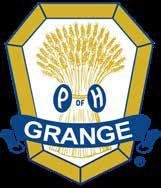
P.O. Box 5272 Fallon NV 89406 775.427.8210


highdesertgrange22@gmail.com
highdesertgrange22

www.grange.org/highdesertnv22
BATTLE BORN STOCKTON WELL GRANGE SHOWS
February 4 | Cavy Cuddles & Bunny Love Show
February 25 | Horse Contest
Horse Judging & Hippology Educational Contests
May 7 | Easy Peasy Horse Show
June 3 | Battle Born Dairy Goat Show

October 15 | Spooktacular Horse Show

Battle Born Stockton Well Grange #29 P.O. Box 302 Silver Springs NV 89429 battlebornstocktonwellgrange29@gmail.com
BattleBornStocktonWell www.grange.org/battlebornstocktonwellnv29
If
Wells Area Deeded Range with Irrigation Permit
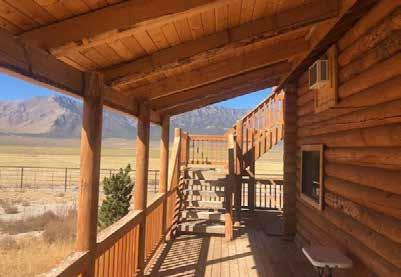
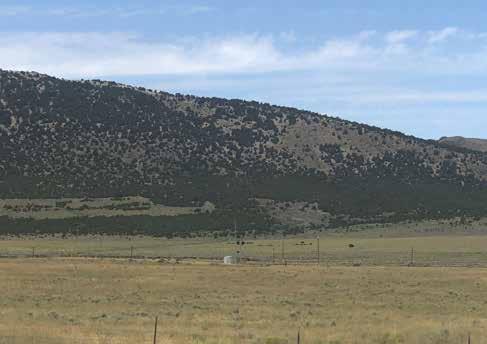
3,796 deeded acres in 6 pastures watered by spring and stock water well. Irrigation permit on 130 acres. Well to be drilled this year. The well costs will be added to price of $2,277,559.
Accredited Land Consultant and Recipient of the 2019 Land Realtor of America Award*
you’re looking to sell a farm or
give me call! For additional information on these properties, visit BOTTARIREALTY.COM
D. Bottari Broker, NV Lic# B 015476 Office: 775.752.3040 Cell: 775.752.0952 paul@bottarirealty.com 1222 6th St. • PO Box 368 • Wells, NV 89835
ranch,
Paul
McGill Area Farm
Welcome Michael Robinson former Montana Rancher!
to just one person in the Realtor’s organization by the Realtors Land Institute (NAR branch specializing in Land, Farms & Ranches. The Progressive Rancher www.progressiverancher.com 8 MAY - JUNE 2023
*Given
Let’s Talk Ag
By Staci Emmn | Editorial
Everything Just Takes More Effort and Time
I want to offer some positive encouragement to our livestock producers out there understanding that everything is just taking a little more effort and time. Right now, specific areas are beginning to be hit with flooding as our temperatures start to increase and snowpack melts. If we increase quickly with temperatures and our nights start to get warm, we could be hit with a lot of water. Counties and irrigation districts are mitigating what they foresee as possible flooding areas, and there are going to be some wash outs. I will again remind you to take pictures and/or keep records if you are impacted by flooding.

We also are very aware of what producers in Northern Nevada are facing as a result of devastating calf-crop losses. I have heard horrific stories from Elko County and Douglas County of up to 40% to 50% losses in calf crops. Hay prices are targeted to remain stable, which will be a higher cost to producers needing hay.
I think as we talk about record keeping and pictures, it becomes more important for producers trying utilize USDA programs. This includes USDA programs such as Natural Resources Conservation Service, Farm Service Agency and Risk Management Insurance programs. The devastating calf-crop losses are going to impact producers this year. I will encourage all producers to access as many programs as you can. It might be a headache, but it could be worth your time in the long run.
I really want to focus on how everything is taking just a little bit more effort. If there is confusion about access to a specific program, at the very least, I encourage you to put in an application. A USDA agency can not deny you the opportunity to submit your application. You can do your best to submit the application, sign it, and turn it into the office. You may be contacted that your application if filled out wrong or you don’t qualify, but there is an appeal process that you can state your case, and get your application on record. Too many times, producers do not want the headache of an appeals process, but leaders cannot make effective change to programs, unless there is documentation that a change needs to occur.
If you feel there is too much confusion or even if you are told you can’t apply, you still have the right to turn in the application. Official regulation will have to be stated on why you were denied. This is where things become officially documented that there could be a problem, or you can state your case as to why you should be approved. Recently, at every turn, it seems I myself am being faced with different regulations regardless of what I try to do. I am learning in working with USDA in our Extension Mobile Harvest Unit that I need the regulation stated back to me with the USDA interpretation. My interpretation of the regulation is sometimes different than what is being told to me by USDA. I also believe that when someone doesn’t know how to deal with you, they tend to shove a regulation/policy at you. This is the worst of the worst as it tends to make the situation more confrontational, instead of taking a step back, and trying to understand different points of view. This doesn’t need to be controversial, but can be an educational process for both parties in finding solutions to move forward. It is the relationship between people that makes the difference and things work. The last thing I want to focus on is producers being able to insure their income. There is a USDA, Risk Management Agency Insurance product that allows producers to insure their income based off of their income tax -schedule F. The Whole-Farm Revenue Protection (WFRP) program provides a risk management safety net for all commodities on the farm under one insurance policy. The insurance plan is tailored for any farm with up to $17 million in insured revenue, including farms with specialty or organic commodities (both crops and livestock). The fact sheet can be found at: https://www. rma.usda.gov/Fact-Sheets/National-Fact-Sheets/Whole-Farm-Revenue-Protection
Everyone’s situation is different. Everything is taking more time. The key is to build the relationships. The other key is to take care of yourself and be healthy and happy.
WVM Headquarters
Consignment Deadline: May 17, 2023
Internet Sale
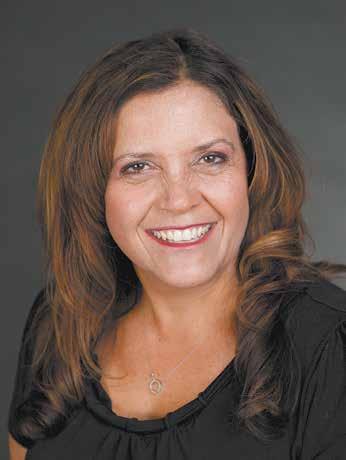
For more information, please call (530) 347-3793 or email us at wvm@wvmcattle.com Look for the catalog and video on ww w.w vmcat tle.com Market your cattle with the professionals! WATCH & LISTEN TO THE SALE on the Web at: U P C O MI N G S A L ES ur • June 8, 2023
• Cottonwood, CA
May 31, 2023
WVM Headquarters
Consignment Deadline:
ur • May 25, 2023
Internet Sale
•
CA
Cottonwood,
The Progressive Rancher www.progressiverancher.com MAY - JUNE 2023 9
Nevada Drought Update for April Drought was alleviated across much of Nevada
Much of the state is now drought-free and potentially at risk for flooding. Wet winters can also mean lots of grass and high fire risk at lower elevations.
Only 5% of the state is classified as D2-Severe Drought, a substantial decrease from just a month ago when 51.35% of the state was D2-Severe Drought. Southern Nevada is likely to remain in drought through June. Resolution of the remaining drought in the rest of the state is likely.
Water levels for many Sierra reservoirs are near or above normal for March. Some may be below normal to have space for snowmelt or other planned water storage. Many western Nevada streams reported above normal flows and record highs.
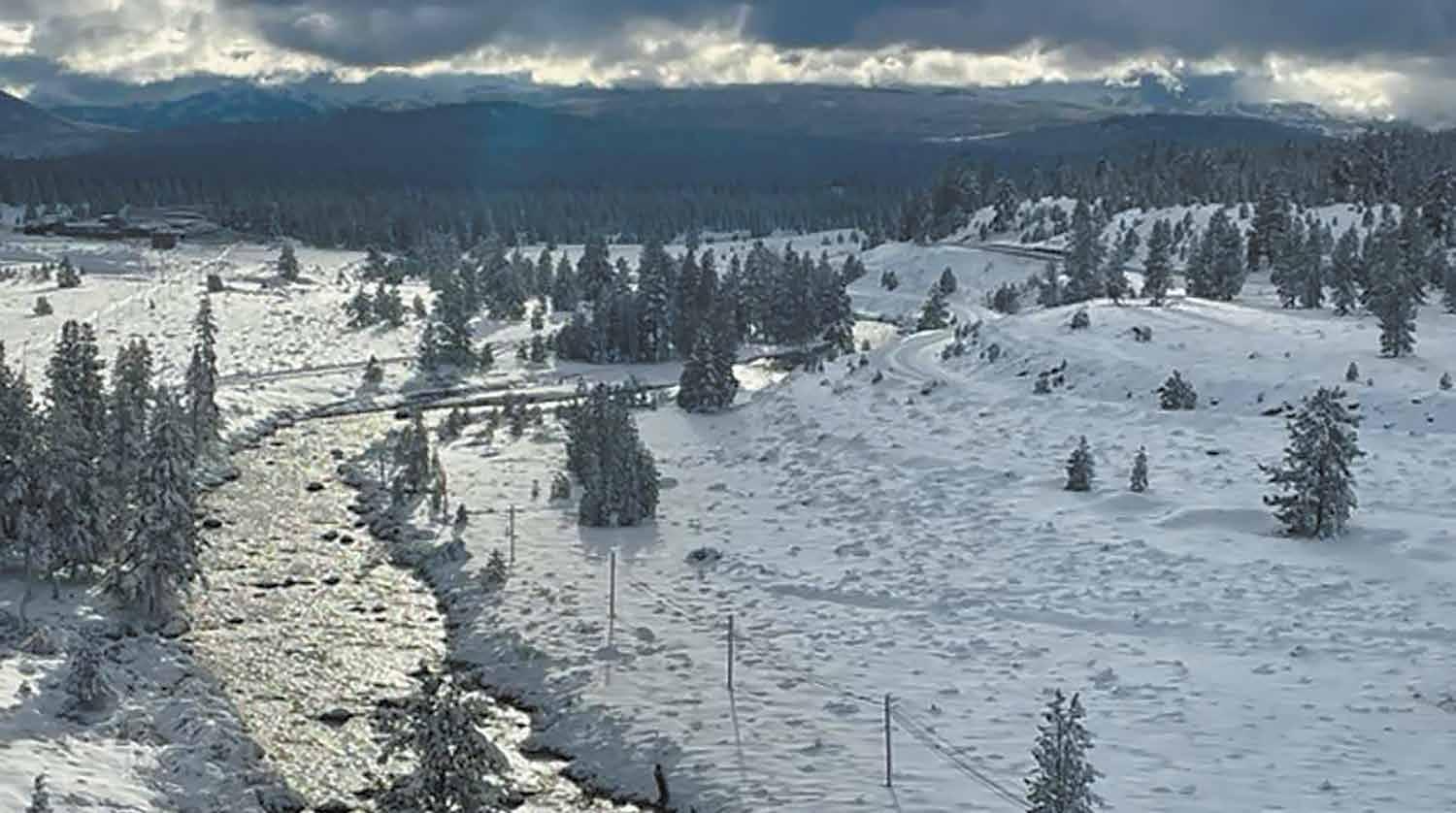
Lake Mead dropped almost a foot to 1,046 feet in late March and is at 28% capacity. Forecasts have Lake Mead dropping to a low of 1,030 feet during mid-summer. Stream flows in the south were variable, with record highs and unusual lows observed.
by Benjamin Khoh, environmental science student
Lifetime Pipe for Agriculture

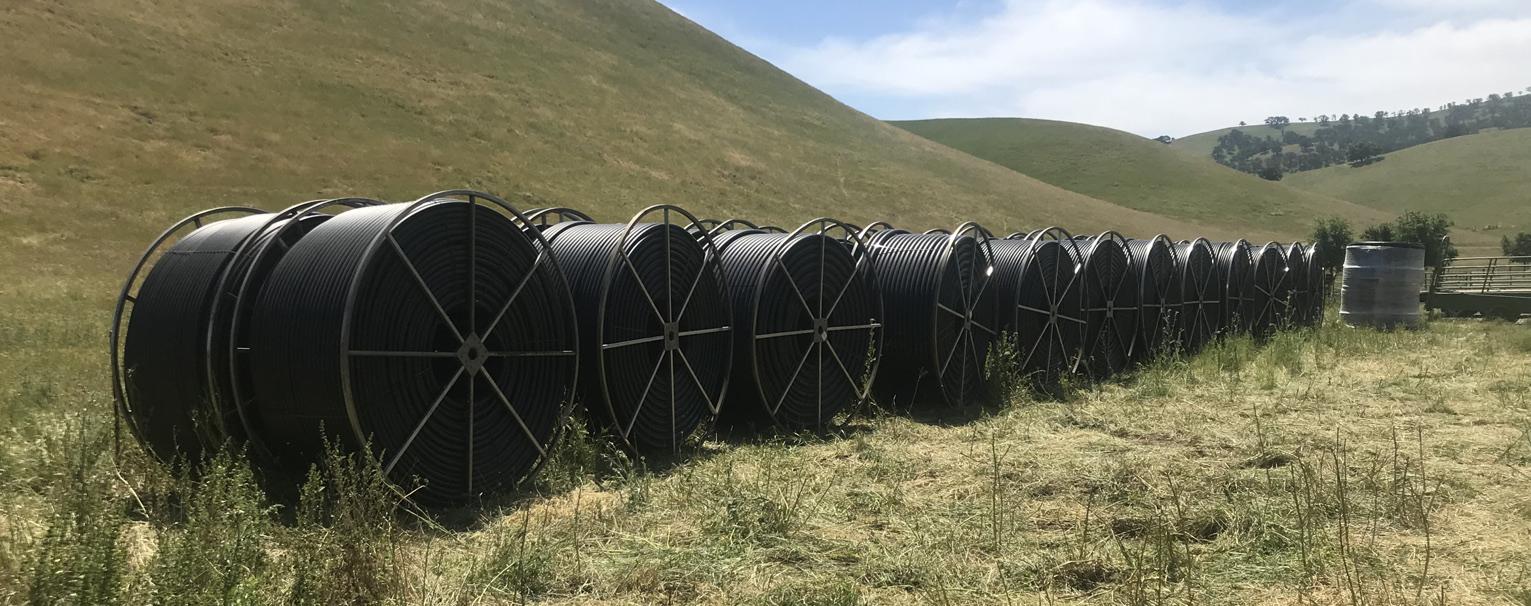
· Durable, efficient alternative to PVC · We are proud of our personalized service and fair prices · We have installed miles of HDPE and can visit with you about your projects · We offer a full line of fusible HDPE pipe 3/4" up to 6" on continuous reels + 48" in sticks + all the fittings Rancher owned. Delivery throughout the West. Burns, Oregon: 541-589-3304 office@westerpolypipe.com westernpolypipe.com WPP Ad.Progressive Rancher..qxp_Layout 1 4/4/23 12:10 PM Page 1
Benjamin Khoh works with Extension’s Nevada State Climate Office and Living With Drought Program, which are led by Extension Climatologist Steph McAfee.
The Progressive Rancher www.progressiverancher.com 10 MAY - JUNE 2023
Most of the state is no longer in drought due to large amounts of precipitation throughout the winter.
Wolf Pack Meats, part of the College’s Experiment Station unit, has resumed its meat processing operations after a four-month hiatus. The team has hit the ground running with plans to increase production to better meet the needs of local ranchers, as well as offer more retail options for the community.
College's Wolf Pack Meats reopens production facility

New partnership increases capacity & retail offerings

During those four months:
• A new boiler was installed.
• A Request for Proposal went out to find a consultant with whom to partner in order to expand processing capacity. As a result, JD Hoagland, CEO of his own processing plant in Homedale, Idaho, was awarded a two-year contract.
• Hoagland hired and trained a group of Reno residents, who have already begun harvesting and processing animals.
Ramping up to meet needs. | Wolf Pack Meats works closely with local farmers, ranchers and small producers, supporting and strengthening the state’s family-oriented ranch system.
“We’re beginning again, really looking at every step of the process and re-establishing the best ways to do this,” Wolf Pack Meats Operations Manager Tom Kulas said. “In the past, we’ve had far more work than we had capacity to do, but now we’ll be able to increase capacity and provide a higher level of customer service.” Looking ahead. | Shorter- and long-term goals are to:
• Feature more pork and lamb offerings, and expand the retail product line to include jerky and sausages.
• Start a home delivery service, begin online sales and establish a presence at farmers markets.
• Build more partnerships, and foster more opportunities for students to gain experience and research to take place.
Wolf Pack Meats is located at 5895 Clean Water Way. Its retail store is open to the public from 8 a.m. to 4 p.m., Tuesdays through Fridays. 775-857-3663
• https://naes.unr.edu/wolf-pack-meats/
Tom Kulas, operations manager (left), and JD Hoagland, consultant, have been working on processes as part of Wolf Pack Meats’ recent production reopening.
Photo and article by Mark Earnest
The Progressive Rancher www.progressiverancher.com MAY - JUNE 2023 11
Best Management Practices for Livestock and Equine during Wildfire Smoke Events
MOVEMENT | If livestock and/or equine must be moved or exercised during a wildfire smoke event, they should be moved slowly, or at a walk. Animals that are asked to jog/trot or run will inhale more smoke and particulates, thus potentially causing more irritation to their respiratory systems. Try to limit additional exposure to dust, which can contribute to the increase in pollutants in the air.
Equine events that are strenuous, such as trail riding, outdoor horse shows, or cutting/sorting events, should be avoided during long-term smoke events.
Plan to give livestock and equine four to six weeks to recuperate from airway damage caused by wildfire smoke after the air quality returns to normal. Attempting to handle, move or transport livestock may aggravate the condition, delay healing, and compromise animal performance for weeks or months to come.
WATER | All livestock and equine should always have access to fresh, clean water, but this is especially true during a wildfire smoke event so animals can stay hydrataed and keep their airways moist. Drinking water also assists with the clearance of inhaled particulate matter by allowing the windpipe (trachea), large airways (bronchi) and small airways (bronchioles) to remove inhaled particulate material in smoke. Dry airways allow particulate matter to remain in the lung and air passages. If water is in a tank or trough, it should be cleaned regularly, as ash and other particles may contaminate it, thus making it undesirable to drink. Water should also be provided very close the feed source.
FEED | Try to limit dust exposure by feeding low-dust or dust-free feeds. Hay may also be soaked before feeding to horses to limit dust exposure. Sprinkling or spraying a dirt pen/lot or a stall with water will also help decrease particulates, which may contain mold, fungi, pollens and bacteria. If livestock feed is ground or mixed, keep in mind this will also be creating additional particulates that may further cause irritation to animals and people.
HEALTH CONCERNS | Animals, like humans, may exhibit signs and experience symptoms that indicate smoke irritation and stress has/is occurring. These symptoms may include watery, red or burning eyes, nasal discharge, difficulty breathing, sneezing, coughing or gagging, wheezing, shortness of breath, aggravated heart and lung diseases, open mouth breathing, increased breathing rate, increased pulse rate, fatigue or weakness, disorientation or stumbling, reduced appetite and/or thirst. If symptoms continue to worsen, contact your veterinarian immediately to determine a treatment plan. Market-ready, obese, older or pregnant animals, as well as those with cardiovascular or respiratory diseases, may experience more challenges during wildfire smoke events. Additionally, lactating animals may have a decline in milk production.
SUSCEPTIBILITY | Not all livestock and equine are alike, so knowing your animal(s) normal behavior and susceptibility to smoke irritation and smoke inhalation injury is very important. Like humans, equine can suffer from asthma in mild to severe forms that can be triggered by inhalation of mold, dust and pollen. Special
care in reducing these triggers is important during smoke events because they are also vulnerable to smokeinduced asthma.
INSURANCE | Purchasing insurance for livestock and equine is always a good option and can cover numerous possible loss (death) scenarios. Animals can be insured as an individual animal, as a blanket policy, as a herd policy or as broad peril. The cost of the insurance policy will depend on what is included and the number of animals insured. If it is believed wildfire smoke inhalation was the cause of death, a veterinarian should be contacted for a necropsy to determine cause of death. For more details and quotes, contact your insurance agency.
It may also be helpful to have photographs of the smoke and visibility, as well as record the AQI when photos are taken. This information may be helpful should you need to pursue an insurance claim.
CONCLUSION | Living in the Western region of the U.S. means there is a chance of living with wildfire smoke. To limit the negative impacts, limit animal movement, provide access to clean water, feed dust-free feeds, create dust-free environments, and watch for signs of distress. Ensuring a good relationship with your veterinarian and having insurance on livestock and equine animals is also highly advisable.
Chichester, L, Kay, M., Roice-Gomes, J., Allen, M., Taylor, L. Emm, S. 2021, Best Management Practices for Livestock and Equine during Wildfire Smoke Events, Extension, University of Nevada, Reno, FS-21-10
EXTENSION College of Agriculture, Biotechnology & Natural Resources FIRE ADAPTED NEVADA
Read the full article at: extension.unr.edu/publication.aspx? PubID=4808 The Progressive Rancher www.progressiverancher.com 12 MAY - JUNE 2023
May is National Wildfire Awareness Month, and here in Nevada, we have good reason to take note –and to take action – according to local experts.
“While all the moisture we received this winter may be helpful in reducing drought conditions, it certainly doesn’t reduce the risk of wildfire, as vegetation will dry out,” said Jamie Roice-Gomes, manager of the Living With Fire Program at University of Nevada, Reno Extension.
Extension and its partners in the Living With Fire Program are kicking off the Nevada Wildfire Awareness Campaign this month, and will be at various community events through the summer and fall, providing information to help Nevadans live more safely with the threat, and reality, of wildfire.
Extension, in collaboration with firefighting agencies and other partners, has developed a myriad of information since the program’s inception over 25 years ago, much of which is now available online.
Roice-Gomes says that for starters, five areas of focus should be: cheatgrass, defensible space, flying embers, evacuation preparation and wildfire smoke.
“These are kind of a ‘big five’ to concentrate on,” she said. “If you want to protect yourself and your family, and hopefully your home, just start chipping away at informing yourself about these, and doing what you can to prepare in advance.”
Here are some tips on getting started with the “big five,” along with links for more detailed information.
1) Remove cheatgrass: Cheatgrass usually dries out quickly and can serve as good kindling for wildfires. Once ignited, and on windy days, these fires can create 8-foot flames traveling at almost 5 miles an hour. After the wet winter, cheatgrass is sure to be growing. Remove all cheatgrass within 30 feet of the home. To learn more about cheatgrass, see the publication A Homeowner’s Guide to Cheatgrass: https://extension. unr.edu/publication.aspx?PubID=2364
2) Create defensible space: Defensible space is when the vegetation around your home has been managed to reduce the threat of wildfire and to allow an area for firefighters to safely defend your home. It is composed of three zones: the ember-resistant zone; the lean, clean and green zone; and the reduced fuel zone: The ember-resistant zone (0 to 5 feet from the home): To reduce the threat of ember ignition, it is critical to routinely remove all dead and flammable vegetation within 5 feet of your home. Remove woodpiles, wood mulch, dead leaves, pine needles, twigs, branches, pinecones, and flammable shrubs such as junipers and sagebrush.
May is National Wildfire Awareness Month Nevadans urged to prepare for wildfire
Living With Fire Program provides information at community events and online resources
The lean, clean and green zone (5 to 30 feet from the home): The goal of this zone is to prevent fire spreading from the vegetation to the home. The term “lean” means that there is only a small amount of vegetation present in discontinuous islands. “Clean” means that all dead plant material is removed, and “green” means that this area is kept irrigated (if appropriate) during dry months.
The reduced fuel zone (30 to 100+ feet from the home): In this zone, it’s important to reduce fire spread and fire moving into the crowns, or tops, of trees and shrubs. Remove any ladder fuels, or vegetation that can bring fire from the ground to the tops of trees, such as dead vegetative debris and lower tree branches.
There is no “one size fits all” approach to defensible space, and these tips do not replace the expert advice of a defensible space inspection. To obtain a free defensible space inspection, contact your local fire agency, which you can find here on the Living With Fire website: www.livingwithfire.com/get-informed/ find-your-fire-district/
For more information on creating defensible space, see the publication Fire Adapted Communities: The Next Step in Wildfire Preparedness: https:// extension.unr.edu/publication.aspx?PubID=2980
3) Reduce the threat of ember ignition to your home: A common way homes ignite is from embers, or pieces of burning material that can travel a mile or more ahead of a fire. Research suggests embers cause up to 90% of home ignitions during wildfires. To reduce the threat of ember ignition to your home:
Ensure that vents are screened with 1/8-inch noncombustible corrosion-resistant metal mesh screening.
Remove all dried leaves, pine needles and other materials from rain gutters.
If you have a roof composed of wood shakes or shingles, consider replacing it, as these roofs are similar to stacking hundreds of pounds of dried kindling on top of your home. Instead, use a Class A-rated roof composed of asphalt fiberglass composition shingles, clay and cementitious tiles (flat and barrel shaped), or some metal roofing materials.
See the publications Be Ember Aware (https:// extension.unr.edu/publication.aspx?PubID=2965) and Wildfire Home Retrofit Guide (https:// extension.unr.edu/publication.aspx?PubID=3810) for more information on reducing the threat of ignition to your home.
4) Be prepared in advance for evacuation: Preparing ahead for evacuation can help you and your household remain calm and safely evacuate, leave your home in a condition that is most conducive to surviving a wildfire, and have the items you need for evacuation and possibly being away from your home for several hours or days. To be prepared for evacuation: Prepare a “go-bag”: Pack an evacuation go-bag ahead of time to aid in a quick and safe evacuation, should one become necessary.
Review and have on hand the Wildfire Evacuation Checklist (https://extension.unr.edu/publication. aspx?PubID=2977 ) which details actions to take should evacuation become necessary and includes a list of what to have in your go-bag.
Always evacuate when asked to do so by firefighters and officials, and put your safety and the safety of others first.
5) Prepare for wildfire smoke: If smoke is in the air, monitor air quality by checking the AirNow Fire and Smoke Map: https://fire.airnow.gov/ To protect yourself from unhealthy conditions:
Stay safe indoors:
• Keep all windows closed and turn on the air conditioner.
• Create a “clean room,” a room with few windows and doors and no fireplace that is a large enough room for your family and a portable air cleaner or air purifier.
• Avoid creating additional smoke or particulate matter in the home.
Protect yourself from smoke if you must be outdoors:
• Use a P100 or N95 respirator while outdoors.
• Reduce strenuous activities and take breaks.
• Stay hydrated. Adequate hydration keeps your airway lubricated, which keeps you safer from health impacts related to smoke. Consult with your doctor for medical advice, especially if you have heart or lung disease, or asthma.
For more on how to prepare for wildfire smoke and protect your health, see the publication Living With Smoke: How to Be Prepared for Smoke Exposure: https://extension.unr.edu/publication. aspx?PubID=4626
For more information, contact Roice-Gomes at jamier@unr.edu.
The Progressive Rancher www.progressiverancher.com MAY - JUNE 2023 13
Interior Department Releases Proposed Plan to Guide the Balanced Management of Public Lands
Public Lands Rule lays groundwork for conserving wildlife habitat, restoring places impacted by wildfire and drought, expanding outdoor recreation, and thoughtful development
The Department of the Interior published a proposal to guide the balanced management of America’s public lands for the benefit of current and future generations. The proposed Public Lands Rule provides tools for the Bureau of Land Management (BLM) to improve the resilience of public lands in the face of a changing climate; conserve important wildlife habitat and intact landscapes; plan for development; and better recognize unique cultural and natural resources on public lands.
The proposed rule directly responds to the growing need to better manage public lands, waters, and wildlife in the face of devastating wildfires, historic droughts, and severe storms that communities are experiencing across the West, as well as to deepen BLM’s collaborative work with communities, states and Tribes to support responsible development of critical minerals, energy and other resources. The proposal is consistent with strategies used by other state and federal land management agencies to ensure the federal government has tools and direction to identify areas in need of restoration or conservation, as well as the ability to encourage investments in public lands to help balance the impacts of development. It will increase access to outdoor recreation by putting conservation on equal footing with other uses, consistent with the BLM’s multiple use and sustained yield mission.
“As the nation continues to face unprecedented drought, increasing wildfires and the declining health of our landscapes, our public lands are under growing pressure. It is our responsibility to use the best tools available to restore wildlife habitat, plan for smart development, and conserve the most important places for the benefit of the generations to come," said Secretary Deb Haaland. “As we welcome millions of visitors to hunt, fish and recreate on our public lands each year, now is the time to improve the health and management of special places.”
“Our public lands provide so many benefits – clean water, wildlife habitat, food, energy and lifetime memories, to name just a few– and it’s our job to ensure the same for future generations,” said Bureau of Land Management Director Tracy Stone-Manning. “As pressure on our public lands continues to grow, the proposed Public Lands Rule provides a path for the BLM to better focus on the health of the
landscape, ensuring that our decisions leave our public lands as good or better off than we found them. We look forward to feedback from the public on how this proposal will help us best uphold the BLM’s important mission.”
The proposed rule would build on the historic investments in public lands, waters and clean energy deployment provided by President Biden’s Bipartisan Infrastructure Law and Inflation Reduction Act by directing land managers to identify and prioritize lands and waters through the land management process that require habitat restoration work, such as removing invasive species or restoring streambanks. BLM lands are an economic driver across the West, and the proposed rule will ensure those lands and the resources they produce continue to be available for future generations.
It also proposes conservation leasing, a tool authorized by the Federal Land Policy and Management Act (FLPMA), to facilitate restoration work on public lands in cooperation with community partners. A conservation lease is a time-limited lease of public land that allows interested organizations to conduct specific restoration or mitigation activities and would generate revenue for the American taxpayer. This tool has the potential to expand opportunities to accelerate restoration of big game migration corridors or establish carbon markets, for example, and directly responds to comments from state and industry partners on the need for a reliable path on public lands by which to pursue compensatory mitigation to facilitate development projects.
The proposed rule includes a roadmap to align the BLM with other land management agencies, such as the U.S. Forest Service, in ensuring the agency is inventorying and assessing the health of public lands, including watersheds, forests and wildlife habitat. In light of the rapidly changing climate and increasing demands on public lands, the additional information will be used to identify trends, implement adaptive management strategies, and ensure decisions are informed by the best available science and on-theground monitoring. It will also be utilized during the existing land management planning processes to identify public lands in need of restoration work or intact landscapes that may be best managed for their contributions to healthy, functioning ecosystems or water quality.
The proposed rule also provides a framework for land managers to apply provisions of FLPMA that direct the BLM to prioritize the identification, evaluation
"Conservation and Landscape Health" A Proposed Rule by the Land Management Bureau Comment period ends June 20, 2023
BLM proposes new regulations that, pursuant to the Federal Land Policy and Management Act of 1976 (FLPMA), as amended, and other relevant authorities, would advance the BLM's mission to manage the public lands for multiple use and sustained yield by prioritizing the health and resilience of ecosystems across those lands. To ensure that health and resilience, the proposed rule provides that the BLM will protect intact landscapes, restore degraded habitat, and make wise management decisions based on science and data. To support these activities, the proposed rule would apply land health standards to all BLM-managed public lands and uses, clarify that conservation is a “use” within FLPMA's multipleuse framework, and revise existing regulations to better meet FLPMA's requirement that the BLM prioritize designating and protecting Areas of Critical Environmental Concern (ACECs). The proposed rule would add to provide an overarching framework for multiple BLM programs to promote ecosystem resilience on public lands.
READ FULL PROPOSAL AND MAKE COMMENTS HERE:
www.federalregister.gov/ d/2023-06310
and designation of Areas of Critical Environmental Concern (ACEC) through land use planning. ACECs are the primary BLM designation for public lands where special management is required to protect important natural, historic, cultural and scenic resources, systems or processes, or to protect life and safety from natural hazards.
The publication of the proposed Public Lands Rule in the Federal Register in the coming days initiates a 75-day public comment period. In addition, the BLM will host five information forums to discuss the details of the rule.

The Progressive Rancher www.progressiverancher.com 14 MAY - JUNE 2023
Wells FFA Dominates at State Convention

 By Morgan Noorda, Wells FFA chapter reporter
By Morgan Noorda, Wells FFA chapter reporter
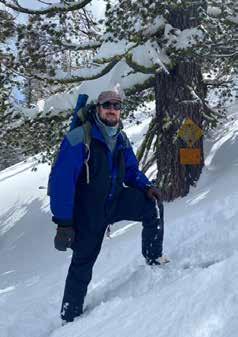


On the cold, windy, snowy morning of March 20, 2023, the Wells FFA chapter loaded up 36 students onto the bus and took off for Reno. The group was overwhelmed with anticipation for the 94th annual Nevada State Convention, and they were more than ready to represent Wells in all their competitive events.
The week was a success! The chapter got the opportunity to visit the Coconut Bowl, where they participated in laser tag, go karting, bowling, and other activities. Students got the chance to be involved with workshops, and attended all four general sessions. In their downtime they also went shopping, and got to eat at many restaurants together.
Although the chapter participated in fun recreational activities, they had their eyes on the prize. For months students rigorously studied for their Career and Leadership Development Events, and the time had come to show their knowledge. Out of around 20 competitive events, Wells FFA brought home 11 gold emblems. Meats Evaluation and Technology (1st place team) included members Taylor Glaser (1st high individual), Cade Cromely (2nd high individual), Marli Dahl (4th high individual), Mason Noorda, Teagen Calton, and Isaac Gale. Farm Business Management (1st place team) included members Jackson Dahl (1st high individual), Jorie Wright (2nd high individual), Madison Wachtel (3rd high individual), Taylor Glaser, Madison Dahl, Spencer Gale, Ian Livingstone, and Grant Kington. Senior Parliamentary Procedure (1st place team) included members Morgan Noorda, Madison Wachtel, Carolina Johnson, Jorie Wright, Spencer Gale, Truman Kington, and Hannah Prescott. Morgan Noorda also received the Outstanding Chair award. Conduct of Chapter Meetings (1st place team) included members Isaac Gale (chairman), Mason Noorda, Marli Dahl, Aron Hanson, Colter Runnion, Carson Ballard, and Lilyanna Borderding. The Conduct of Chapter Meetings team consisted of all 8th graders, and freshman Carson Ballard. Best Informed Greenhand (1st place team) included members Cameron Livingstone (1st high individual), Grace Otto (2nd high individual), Carson Ballard (3rd high individual), Charleigh Fender, Cade Cromely, Gage Uhlig, Teagan Calton, and Kendall Matsler. Poultry Judging (1st place team) included members Gage Uhlig (1st high individual), Cameron Livingstone (2nd high individual), Carson Ballard (3rd high individual), Cristina Salazar (4th high individual), and Liz Rivera-Casas. Morgan Noorda competed in Employment Skills and received first high individual. Milk Quality and Products (first place team) included members Christopher Burcham (4th high individual), Jackson Dahl (5th high individual), Truman Kington and Spencer Gale. Soil and Land Judging (1st place team) included members Spencer Gale (1st high individual), Carson Ballard (2nd high individual), Teagan Calton (4th high individual),
Gage Uhlig (5th high individual), Grant Kington, and Cameron Livingstone. Rangeland Management (1st place team) included members Ian Livingstone (1st high individual), Truman Kington (2nd high individual), Jake Glascock and Hannah Prescott. Novice Floriculture (1st place team) included members Evelyn Walz (2nd high individual), Madison Dahl (5th high individual), Cristina Salazar, Callie Brodsho, and Liz Rivera-Casas. Carolina Johnson competed in Extemporanous Speaking and received 2nd high individual. Agriculture Sales and Service (2nd place team) included members Truman Kington (3rd high individual), Madison Wachtel, Carolina Johnson, and Grace Otto. Agriculture and Mechanics (3rd place team) included members Wheeler Johns, Jake Glascock, Grant Kington, Will Peterson, and Anton Mesna. Environmental and Natural Resources (3rd place team) included members Grant Kington (4th high individual), Ian Livingstone, Hannah Prescott, Jake Glascock, Wheeler Johns, Anton Mesna, and Will Peterson. Karely Olan competed in Creed Speaking and received 3rd high individual. Horse Evaluation (6th place team) included members Grace Otto, Hannah Prescott, Madison Wachtel, Heather Prescott, Charleigh Fender, Callie Brodsho, and Kendall Matsler. Mckenli Myers and Zion Mckay were recognized for receiving their American FFA Degree in 2022. Wells FFA also congratulates State Degree recipient Carolina Johnson, and last but not least, the 2023-2024 Nevada FFA State President, Morgan Noorda.
The chapter is looking forward to a busy and fun spring season, and they are preparing for their annual chapter banquet in May.
Natural Resources Conservation Service Nevada Water Supply Outlook Report April 1, 2023 Photo Credit: Jeff Anderson Massive March Produces All-time Snowpack Records The Sierra Nevada and Great Basin saw record March snow accumulation on top of already staggering snow amounts. April 1st snow measurements set new records at many locations across the region To see how much snow was added between the last two snow surveys compare the yellow and orange signs on the tree in the background of the pictures Above are Evan Smith and Valerie Bullard NRCS Snow Surveyors from Grass Valley, California. Their February 23rd measurement at Rubicon #1 snow course in the Lake Tahoe Basin on averaged 150 inches (12.5 feet) of snow depth containing 57 inches of snow water content. By the next survey on March 30th (right) the marker signs are nearly buried. This measurement recorded snow being 223 inches (18.5 feet) deep containing 88.9 inches of water content. The measurement was 223% of the April 1 median and represents a frozen reservoir equal to 7.5 feet of water sitting on the mountainside. February 23, 2023 March 30 2023 Page 1 Natural Resources Conservation Service National Water and Climate Center
This month’s report and forecast tables are available on the Nevada Snow Survey Webpage: www.nrcs.usda.gov/wps/portal/wcc/home/ quicklinks/states/nevada/ Latest News, Reports & Forecasts and daily, monthly and yearly maps & charts f or Streamflow, Water Supply, Snow and Precipitation; Interactive SNOTEL Charts and Basin Summary Charts The Progressive Rancher www.progressiverancher.com MAY - JUNE 2023 15
Nutritional Value of Antelope Bitterbrush
 By Charlie D. Clements and James A. Young, Rangeland Scientists, USDA-ARS,
By Charlie D. Clements and James A. Young, Rangeland Scientists, USDA-ARS,
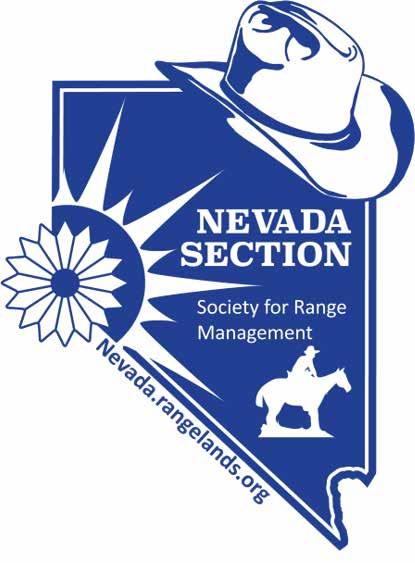
Purshia species, such as antelope bitterbrush, are very important in the nutritional demand of mule deer, and to a lesser degree, domestic livestock. In order to appreciate the nutritional aspects of antelope bitterbrush, some understanding of the unique nutritional requirements of mule deer, the primary consumer of antelope bitterbrush browse is necessary (Fig. 1).
Analysis of forage samples are among the first scientific tests applied by resource managers attempting to better understand the role of forage plants in the ecology of western rangelands. Most analysis focused on grasses rather than shrubs since the objective was to better understand the forage requirements of domestic livestock rather than mule deer. By the late 1930s, wildlife ecologists were making serious attempts to better understand the nutritional requirements of mule deer. Wildlife ecologists, L. A. Stoddard and J. E Greeves reported on their attempt to conduct forage analysis of grasses shrubs and forbs on mule deer summer ranges in Utah. Noting that their forage analysis occurred on summer range habitat rather than mule deer winter ranges, they noted that antelope bitterbrush had a crude protein content of 15.4%, and therefor
concluded that antelope bitterbrush is a highly reliable source of browse. Crude protein is often considered the most important dietary nutrient, as ungulates cannot survive without it. Even a slight deficiency adversely affects reproduction, lactation, and growth. Ruminants need protein in order for the rumen microorganisms to digest and metabolize carbohydrates and fats effectively. The nutrient, usually reported as crude protein, is a measure of protein and nonprotein nitrogen. The amount of nitrogen compounds present in various vegetation classes varies with the kind of tissue, age or stage of development, and the time of season. In general, shrubs like antelope bitterbrush contain higher percentages of crude protein than do grasses and forbs during the fall and winter months, yet lesser amounts during the spring and summer months. It is not uncommon to have a rancher gathering cattle in the fall to find his stock in an antelope bitterbrush stand due to the preference for digestible crude protein.
Most of the plant material eaten by mule deer and other ruminants consists of some form of carbohydrates, which provide most of the energy needed in the diet. Fats, lipid and related substances
are frequently reported in nutritional analysis as crude fat. True lips are simple lips, true fats and oils, compound lipids, and derived lipids such as saturated and unsaturated fatty acids. Most of these are digestible to some degree by ruminants, but some of the other soluble compounds such as terpenes and resins, are not digestible and may be harmful to rumen function, which we will touch on later.
Fats are a highly important food reserve in animals because they contain almost twice as much energy per unit weight as carbohydrates and protein. While the fat content of dry fruits and seeds of shrubs may be as high as 70%, lipids rarely make up 5% of the stem and leaf constituents. Fats are synthesized in the rumen from carbohydrates and proteins, therefore ruminants such as mule deer do not require fats in their diet, but wintering animals prefer and do well on diets consisting of shrubs such as winterfat, mountain mahogany and antelope bitterbrush. Rocky Mountain juniper tests high for crude fat but is high in essential oils that interfere with rumen function. Secondary compounds of terpenes are also present in big sagebrush, and as reported by animal nutritionist D. R. Diets, when mule deer consume 55% or more big sagebrush in their diet, the high levels of volatile oils can significantly harm rumen function and result in mortality. That is why it is so important to have diverse shrub communities in which mule deer can browse multiple shrub species and benefit from the nutritional value big sagebrush provides, without consuming toxic levels of volatile oils (Fig. 2). Ruminants, such as mule deer, must have access to adequate calcium and phosphorus. Calcium and phosphorus compounds form 90% of the mineral matter in the skeleton of most ruminants and about 75% of that in the entire body. On western rangelands, calcium supplies are usually ample in shrubs. Phosphorus is vital in many body processes including skeleton strength, intracellular fluids and compounds such as nucleoproteins and phospholipids. A deficiency in phosphorus or a high calcium to phosphorus ration may result in weak young (fawns), decreased lactation, failure to conceive and other abnormalities. Phosphorus is deficient in many shrub species on western rangelands during
Great Basin Rangelands Research Unit
The Progressive Rancher www.progressiverancher.com 16 MAY - JUNE 2023
Figure 1. Vigorous antelope bitterbrush stands provide critical nutrition for wildlife and domestic livestock, especially mule deer.
the winter months. Most ruminant nutrient intake goes towards maintaining its general metabolism. Browse species such as antelope bitterbrush, mountain mahogany and big sagebrush are good sources of energy, but as shrubs become older their nutritional value decreases as well.
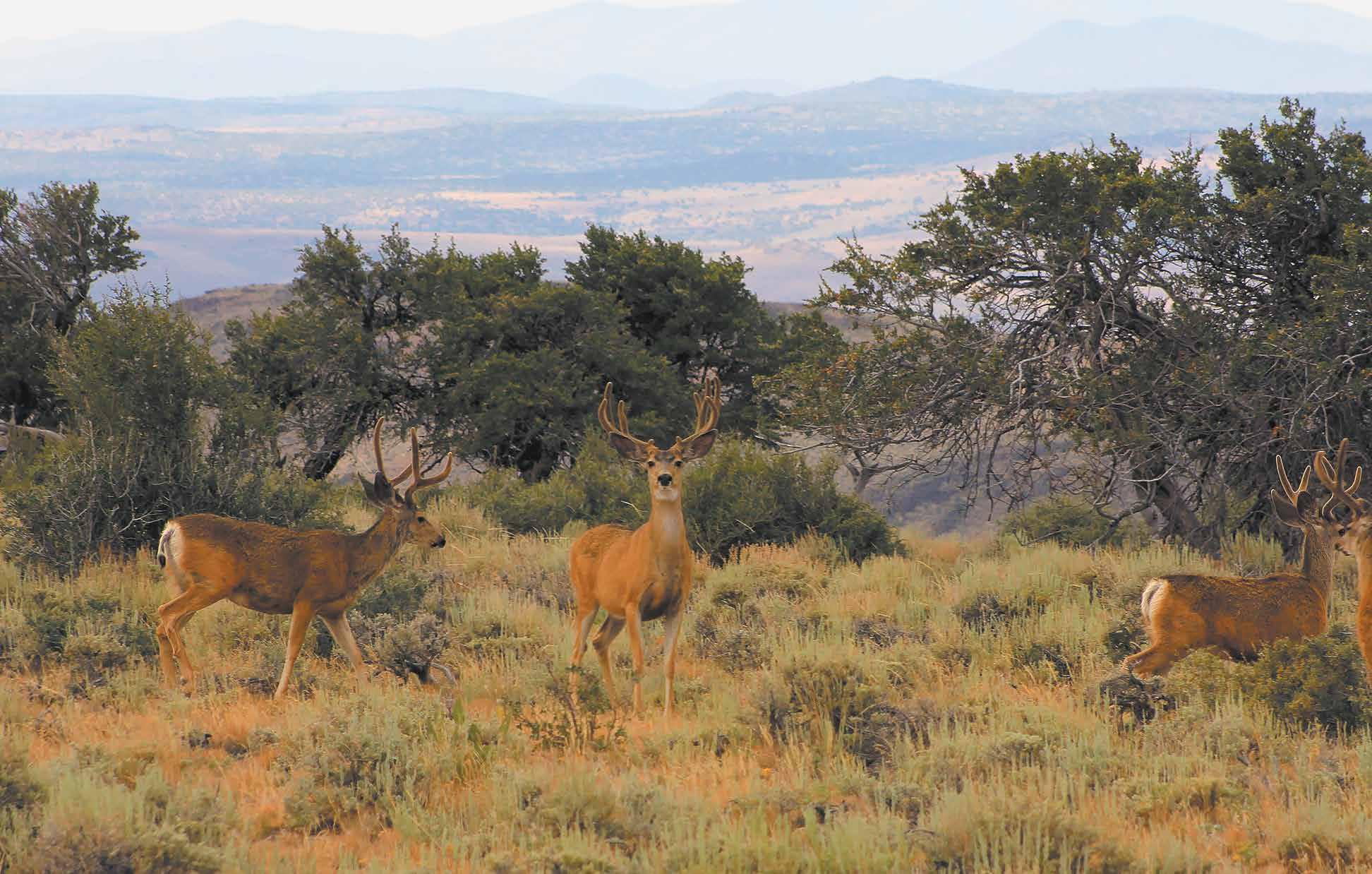
Much of what is known about the nutrition of mule deer comes from the pioneering research of Arthur D. Smith, a long-time professor at Utah State University who worked in cooperation with the Utah Fish and Game Commission. One of the first papers Smith published on mule deer nutrition

concerned the digestibility of big sagebrush. Based on field observation he reported that mule deer commonly consumed big sagebrush herbage and on winter ranges big sagebrush consumption increased, especially when more desirable species such as antelope bitterbrush were not available. Wildlife biologist, Harold Bissel and his associates in the California Department of Fish and Game conducted digestibility trials of antelope bitterbrush and big sagebrush in northeastern California in the mid-1950s. Bissel reported good intake of antelope bitterbrush by mule deer, but when compared to
big sagebrush, mule deer could not maintain body weight. Bissel calculated the energy requirements from his experiments and reported that mule deer consumed about 4,500 calories per 100 pounds of body weight, the maintenance requirement of a resting and fasting mule deer was 1,140 calories per day/100 pounds of body weight. Bissel reported that antelope bitterbrush could maintain body weight as a sole source of forage, which was not the case with big sagebrush.
Wildlife biologist, R. W. Lassen obtained similar results on the nutritional importance of antelope bitterbrush to mule deer in northeastern California with the Doyle mule deer herd. Lassen’s team analyzed 213 mule deer stomachs during the winter of 1949-1950 and reported that the primary browse was big sagebrush, however they noted that the mule deer they examined (natural death and road kill) were in very poor condition. By April they reported that 30% of the deer they examined exhibited signs of advanced malnutrition with the herbaceous species most frequently found in the diets of mule deer to be alfalfa and cheatgrass. They reported that grass made up 56% of the mule deer diet from November 1949 through March 1950. Once antelope bitterbrush began its growth in April, grass declined to 5% of the diet.
Other studies by Bissel, with the aid of California Department of Fish and Game wildlife biologist Howard leach, reported that antelope bitterbrush was preferred from September through November in the diet of the Lassen-Washoe mule deer herd, by December antelope bitterbrush and big sagebrush consumption by mule deer was nearly equal and big sagebrush increased to greater portions of the diet than antelope bitterbrush in February and March. It is important to remember that during this time period in northeastern California, antelope bitterbrush was the keystone browse species and inherent bias may have played a role in the overall reporting.
Howard Leach, whom analyzed more than 3,000 mule deer stomachs reported to us that mule deer in northeastern California preferred antelope bitterbrush from September to midDecember and that the availability of vigorous antelope bitterbrush stands was critical in allowing mule deer to obtain the nutritional values of antelope bitterbrush as they make their way to winter ranges. He reported that even though the preference for big sagebrush increased from December through March, the worst condition the mule deer was in coming into winter range habitat, the more mortality the deer herd would experience. “Foods of Rocky Mountain Mule Deer” that was published back in 1973 had already listed 52 publications referring to the foraging of mule deer on antelope bitterbrush. Nonetheless, mule deer are not the only browsers that consume antelope
Figure 3. Mule deer are browsers, therefore benefit when multiple productive browse species are available throughout their habitat.
...continued The Progressive Rancher www.progressiverancher.com MAY - JUNE 2023 17
Figure 2. Ability of mule deer to browse on a variety of nutritional species in conjunction with mule deer reduces the negative impacts of consuming browse species with volatile oils.
bitterbrush. Bighorn sheep, elk, moose and pronghorn antelope also utilize the nutritional value that antelope bitterbrush provides. Montana Department of Fish, Wildlife and Parks reported, in research they funded, that antelope bitterbrush made up more than 50% of the mule deer diet. In their report they pointed out the significant increases in Elk populations and that antelope bitterbrush nutritional value was preferred by elk as well, resulting in habitat competition. Even though the elk diet was more diverse, major browse species that made up 95% of mule deer diets also made up 55% of elk diets.
In southcentral Wyoming, antelope bitterbrush made up 80-90% of pronghorn and mule deer summer and fall diets, suggesting yet another sign of resource competition for antelope bitterbrush.
In western Colorado, Range Scientist R. M. Hansen reported that Utah serviceberry and antelope bitterbrush made up 96% of mule deer summer, fall and early winter diets. Hansen also reported that with an increase in nutritional browse species such as antelope bitterbrush, mule deer could utilize the nutritional value of pinyon and juniper and offset rumen complications of volatile oils associated with these two tree species. Preference of forage species is often related to abundance, but can also be due to the plants volatile oils as discussed with big sagebrush and pinyon or juniper trees which can be recognizable by smell or taste. Again, the more availability of vigorous browse species such as antelope bitterbrush, serviceberry and mountain mahogany the more that browsers such as mule deer can utilize nutritional browse species with volatile oils that can harm rumen function (Fig. 3).
Habitat changes over-time have resulted in a decrease in shrub communities, including antelope bitterbrush, which have resulted in former big sagebrush/bunchgrass communities being converted to annual grass dominance, cheatgrass, therefore increasing the chance, rate, spread and season of wildfires that in return threatens critical unburned browse communities. Also, many browse communities are becoming old and decadent and providing less nutritional value for wildlife, especially mule deer.
We have reported on the age of antelope bitterbrush stands that are well over 70 years of age. Once antelope bitterbrush plants reach 60-70 years of age they start to decline in nutritional value, leader growth, seed production and recruitment ability. We reported that antelope bitterbrush shrubs that average 30-40 years of age produced an average of more than 90,000 seeds per shrub compared to shrubs that average 90-100 years of age producing less than 900 seeds per shrub.
Granivorous rodents are the primary dispersal mechanism of antelope bitterbrush seed. Granivorous rodents exhibit two types of dispersal behavior: larder hoarding is the behavior in which they harvest the seed and take the seed deep within their burrows, these seeds may germinate,
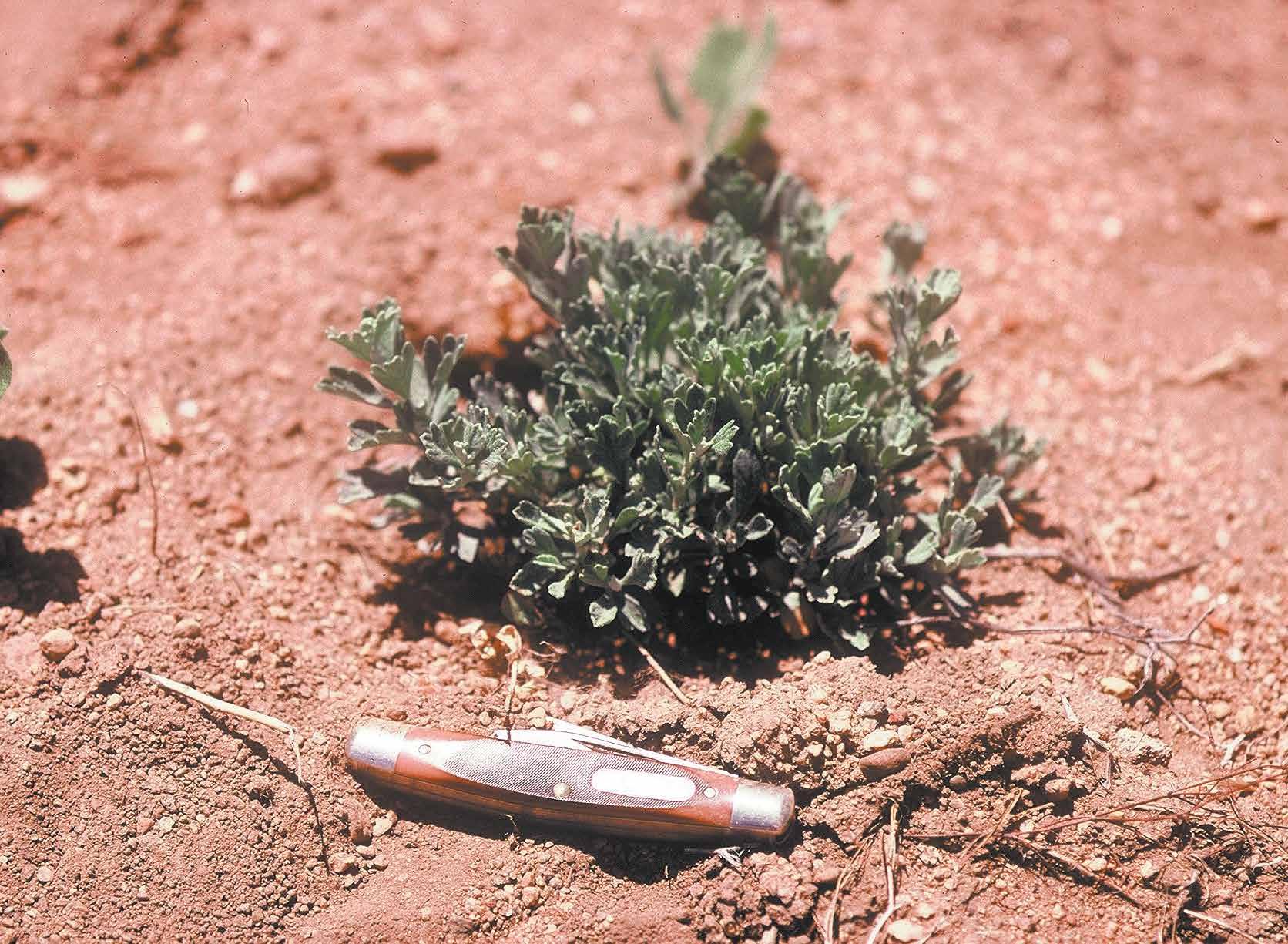
but are not available for emergence and establishment. Their other behavior is scatter hoarding, this is where they harvest the seed and disperse the seed in shallow depressions throughout their home range. Rodents harvest approximately 98% of the bitterbrush seed that falls to the ground and consume about 76% of those seeds. Roughly 52% of the bitterbrush seed that was produced on the plants were damaged by insects or frost. Therefore, the more seed production, the more scatter hoard caches, the more opportunity for seedling emergence and establishment to be recruited into the community.
The recruitment of new plants is critical in sustaining any plant community, but with the exceptional preference for antelope bitterbrush, this important browse species relies even more heavily on sustaining vigorous nutritional forage for mule deer, other wildlife species and domestic livestock for many decades (Fig. 4). Therefore, the restoration of antelope bitterbrush throughout its’ range is critically important to numerous habitats and the wildlife and domestic livestock that depend on these habitats, especially mule deer.
Suggested Reading:
Bishop, C.J., Garton, E.O. & Unsworth, J.W., 2001. Bitterbrush and cheatgrass quality on 3 southwest Idaho winter ranges. Journal Range Management 54(5):595-602.
Bissell, H.D. and Strong, H., 1955. The crude protein variations in the browse diet of California deer. California Fish and Game, 41(2), pp.145-155.
Clements, C. D. and J. A. Young. 1997. A viewpoint: Rangeland health and mule deer habitat. Journal Range Management 50(2):129-138.
Clements, C.D. and Young, J.A., 2001. Antelope bitterbrush seed production and stand age. Journal Range Management 54(3):269-273.
Dietz, D. R. and J. G. Nagy. 1976. Mule deer nutrition and plant utilization. pp. 71-78. IN: Mule deer decline in the west. Utah State University, Logan, UT.
Frisina, M.R., Wambolt, C.L., Fraas, W.W. and Guenther, G., 2006. Mule deer and elk winter diet as an indicator of habitat competition. Proceedings-shrublands under fire: disturbance and recovery in a changing world, pp.123-126. June 6-8; Cedar City, UT.
Lassen, R.W., Ferrel, C.M. and Leach, H., 1952. Food habits, productivity and condition of the Doyle mule deer herd. California Fish and Game 38(3):211-224.
Leach, H.R., 1956. Food habits of the Great Basin deer herds of California. California Fish and Game 42(3):243-308.
Stoddart, L.A. and Greaves, J.E., 1942. The composition of summer range plants in Utah. The composition of summer range plants in Utah. Bulletin 305, Utah Agriculture Experiment Station, Logan, UT.
Wambolt, C.L., Fraas, W.W. and Frisina, M.R., 1996. Variation in bitterbrush (Purshia tridentata Pursh) crude protein in southwestern Montana. The Great Basin Naturalist pp. 205-210.
...continued
Figure 4. Antelope bitterbrush seedling being recruited into the community via granivorous rodent caching behavior.
The Progressive Rancher www.progressiverancher.com 18 MAY - JUNE 2023
FORT RANCH
FOR INFORMATION & CATALOG REQUESTS CALL:
Landon Hall
208-680-9041 or www.fortranch.com

Peptoboonsmal x Meradas Little Sue
Silver Savanah
Moon
Once In A Blu Boon x Savanah Holli Cat Suep
High Brow Cat x
Meradas Little Sue
Cow Kwacker
High Brow Cat x Kwackin
Dun It With A Twist x Melimelo Kid
Smart Zee
Lena
Smart Little Lena x Zee Dualy
Stylish Fever Prom
Playboys Buck Fever x Telenastyle
Frank VanderSloot
2880 North 55 West Idaho Falls, ID 83402
208-528-6635
Mitch Jacobs
2496 North 2375 East Hamer, ID 83425
208-662-5530
208-589-1951
Saturday, June 24, 2023
10:00 Sale Preview

11:30 Fort Ranch Sale Begins
Complimentary lunch served throughout the sale
Bodee Boonsmal Cat Ichi
CD Lights
Dual Rey
Gun Goes Boon
Hickorydickory Doc
High Brow Cat
High Brow CD
Little Pistol Badge
Metallic Cat
Mr Skyline Peppy
One Time Pepto
Playdox
Playin Stylish
Quite A Boon
Ricochets Sue
Smart Little Lena
Smooth As A Cat
TR Dual Rey Zoom Zoom Shorty
Sale Terms: 1/3 down payment with balance to be paid in September when foals are weaned and picked up by their new owners. Foal guaranteed to be alive and sound or your down payment will be refunded.
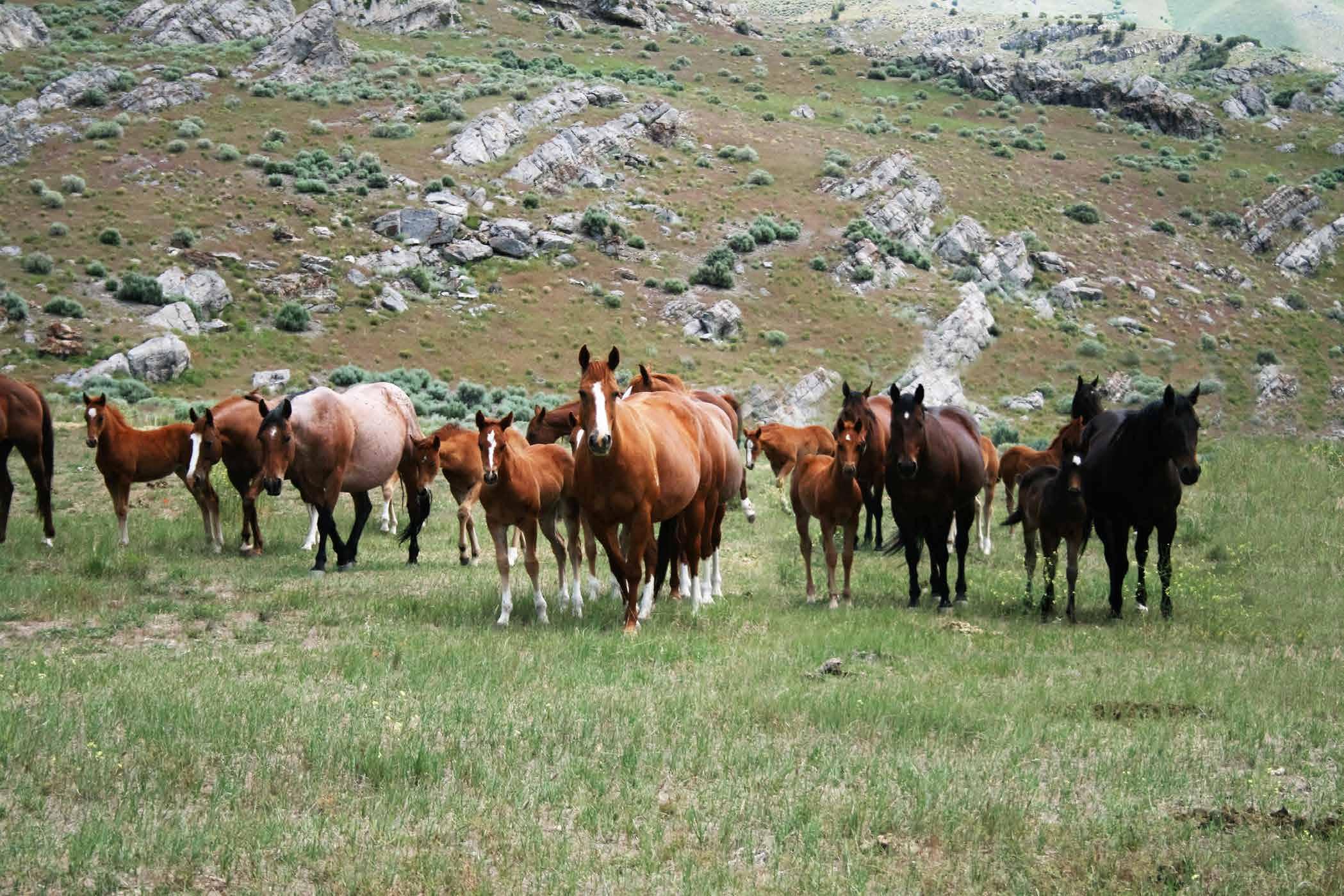
The Progressive Rancher www.progressiverancher.com MAY - JUNE 2023 19
U.S. Department of Interior Proposes New Plan For Management of Public Lands
By Doug Busselman | NFB Executive Vice President
Wikipedia tells us that “doublespeak” is a merger of two concepts taken from George Orwell’s novel “1984,” combining “doublethink” and “newspeak”. The useful explanation further states that ‘Doublespeak’ – “Is a language that deliberately obscures, disguises, distorts or reverses the meaning of words.”
With this in mind we turn to the headline on a March 30th Department of Interior news release which purports “Interior Department Releases Proposed Plan To Guide the Balanced Management of Public Lands.” From this headline, the rest of the news release promotes the rule that they believe will result in “balanced management” of Bureau of Land Management (BLM) lands by following the game plan of the 88page document.
As has become the mantra of the Biden Administration, our present conditions of facing devasting wildfires, historic droughts and severe storms are the reasons for the response of our government. By changing the rules to implement more Areas of Critical Environmental Concern (ACEC) designations and putting “conservation” on an “equal footing with other uses” their vision of what multiple use means will be realized. It would be mild to say that this proposed rule was a bit of a surprise, given the way in which it popped up without any indication that it was even being considered. Regardless of being a surprise, the proposed rule will need to be given attention and a response. The 75-day comment period began when the April 3, 2023 Federal Register Notice carried the proposal and is scheduled to end on June 20th.
Efforts are gearing up to review the details within the proposed plan, evaluate the various background requirements for what the Federal Land Policy and Management Act (FLPMA) require as well as how current regulations and agency manual directives fit things together. FLPMA is part of the jurisdiction that the agency is maintaining as giving them the justification for inventing “conservation” as a “use” on par with other uses.
A lot of attention is also focused on increased designation of ACECs for protecting natural, cultural and scenic resources on BLM managed lands. This is along with considering special management attention for ACECs in land use planning.
What we might want to figure out is whether the one-and-a-half million acres already designated in Nevada over the 54 identified ACECs are accomplishing anything worthwhile already? How has the “management” of these areas enhanced the hoped-for benefits and resource conditions that began with their designation? What are the “management” activities and monitoring responses been since they became ACECs?
The framework envisioned by the proposed rule describes, in the agency’s own view, that BLM has three primary ways to manage for resilient public lands:
1 Protection of intact, native habitats
2 Restoration of degraded habitats
3 Informed decision-making, primarily in plans, programs and permits
Some might argue that doing things on the public lands could be a great addition to addressing wildfires and declining health of our landscapes.
Perhaps in the mix of “management” that could help, reaching Appropriate Management Levels (AML) of Wild Horses and Burros populations might go a long way in responding to degraded habitats?
None of the real-world “doing something” things are as stimulating as developing new regulations to further plan for creating new stuff to not actually do anything. Although “conservation” will now have a definition that is only slightly circular in its meaning… “Conservation means maintaining resilient, functioning ecosystems by protecting or restoring natural habitats and ecological functions.” Somehow that is going to be on equal footing with all other uses – or so we’re promised.
Conservation Leases is an interesting new addition to the toolbox that our Washington, D.C. landlords propose. They say that the meaning will clarify “that the existence of conservation leases would not in and of itself preclude the public from accessing public lands for noncommercial activities such as recreation.” Adding however, “Some public lands could be temporarily closed to public access for purposes authorized by conservation leases, such as restoration activities or habitat improvements.”
It was not that long ago when the Biden Administration was pronouncing their desire to see 30 percent of the country’s land and waters “protected” by 2030 (seven years from now). Along with a lot of gibberish and widely circulated documents which never explained much of anything we were supposed to believe that “working lands” would somehow fit into the formula for the calculations of “protecting.”
Some might have considered that as “doublespeak.” A more polite idea than our government of lying to us.
Then again reading the new “Proposed Plan to Guide the Balanced Management of Public Lands,” considering what the words say in their plain meaning as opposed to what the regulation writers are attempting to suggest that we ought to believe… “1984” begins to shift from an interesting novel to more of an explanation of a report on what is being carried out.
Ideally there will be a significant pushback on the proposed regulations with varied and multiple responses hammering hard on the weakness of created definitions and imagined authority.
Given the preponderance of BLM managed lands in Nevada, our state has the most at stake in dealing with the consequences of those who promote non-use as being on equal footing with the multiple uses that Nevada citizens depend on for their livelihoods. Whether private, local government units or through the state agencies which have linkage to the interests of multiple use, Nevada needs to reply to the proposed rule offered by the Department of Interior. Beyond the administrative avenue of submitting public comments, political and judicial strategies need to be in the development stages for our response to the proposed rule.
Please be in contact with your elected representatives as well as connect with your advocacy groups to formulate the response that this proposed rule deserves.
Nevada Farm Bureau
The Progressive Rancher www.progressiverancher.com 20 MAY - JUNE 2023
Students Experience 2023 Ag in the Classroom Event
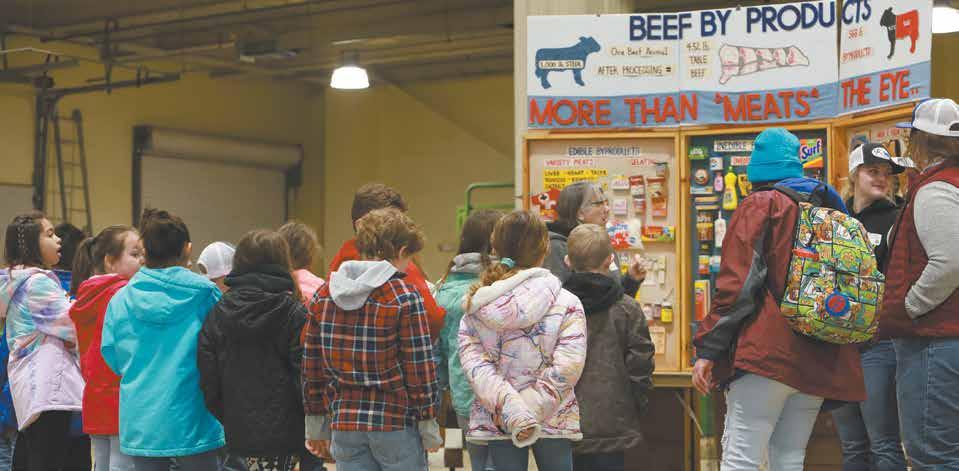
The Humboldt County Farm Bureau Ag in the Classroom Event, took place on March 28, 2023 at the Winnemucca Events Center. Third grade students from throughout the county filled the building to experience a day of educational programming to learn about agriculture. Students, along with their teachers, visited fourteen presentation stations throughout the day. The stations were led by local adult and youth presenters from Humboldt County. Many of this year’s stations offered hands-on activities for the students to experience. The Veterinary station taught students what happens at a vet visit. Students learned about x-rays, ultrasound, what centrifuge is and how microscopes and slides help in identifying animal disease and illness. Students learned about sheep production, sheep products, and got to visit with animals at the station. They got an indepth lesson on potatoes and learned that potatoes grown locally might end up in bags of chips they eat. They learned about dairy cows, production and products. Students enjoyed learning about working dogs and how they help ranchers on a daily bases and the Poultry station was egg-citing and a big hit with the students! Students learned about horses, horse feed and what it takes to care for a horse. They learned about goats and beef cattle. The Beef-by Products station provided an eye-opening experience for students as they learned about every day products they use or consume and how the by-products of beef are incorporated into those items. Students learned about beneficial and invasive bugs at the Bug station and spent time learning about plant seeds at the Seed station. Students got an agriculture history lesson and made a living necklace at the President Farmer station and experienced agriculture with virtual reality at the Nevada Ag Wagon station. During the lunch time break, students visited the Plant a Seed activity station and planted seeds to take home. The Ag in the Classroom committee are extremely appreciative to have wonderful volunteer presenters from throughout Humboldt County who come to share their knowledge and expertise with the students. FFA and 4-H youth contribute and help out at the event, which allows the younger students to interact with and learn from the older youth.
The yearly event is made possible through the hard work and dedication of the Humboldt County Farm Bureau Ag in the Classroom committee. The committee spends months planning the event, gathering resources, support and volunteers to ensure the event happens. The committee provides the third-grade teachers with a “teacher ag bag,” filled with educational resources they can use with their class. The book and accompanying educators guide included in this year’s bag was, “How to Grow a Monster,” which is the American Farm Bureau Agriculture Foundation book of the year. The many ag related resources and lessons in the bag can be used leading up to and after the event to help prepare and reinforce the in-person learning experience for the students. The students receive a “student ag bag” at the conclusion of the event, which is filled with a variety of fun and educational ag related items donated by sponsors, supporters and presenters of the event.
The Ag in the Classroom Committee hopes the event creates a lasting impression on students and connects them to the importance of where food, fiber and other ag related products come from and how agriculture plays a vital role in our everyday life. The feedback from this year’s event has been extremely positive. The thank you notes from the students are heartwarming to read. The Humboldt County Farm Bureau Ag in the Classroom committee, in partnership with the Nevada Farm Bureau Federation and our many supporters, look forward to the continued tradition of putting on an educational, interactive agriculture learning experience for the youth in Humboldt County for many years to come.
By Brittney Money | Director of Communications
Cruising Across Nevada
The Nevada Ag Wagon is hitting the road and is most likely making a stop at a county near you. Previously known as the World of Corn trailer, it's had a complete makeover and is now known as the Nevada Ag Wagon “We’re Growing Places.”
A lot of exciting makeovers went in to redoing the trailer to make it a great new tool for not only county events, but a great resource for Ag in the Classroom events as well. The trailer now features 3D models of agriculture represented by Nevada’s 17 counties, as well as 30 new VR Headsets that will also teach kids in an exciting way. The new trailer design is not only more interactive for people walking through it also has more educational aspects as well.
You can follow along with the Nevada Ag Wagon on our Facebook and Instagram pages. A full list of Nevada Ag Wagon stops can also be found on the Nevada Farm Bureau website at nvfb.org under the events section.
Growing Ag education in the state of Nevada is a huge goal for the Nevada Farm Bureau this year. Woody Worthington, the Nevada Farm Bureau’s Director of Agriculture Education and Advocacy, is especially focused on advancing Ag education throughout the state.
Counties can book the Nevada Ag Wagon for county events as well as Ag in the Classroom events. If interested in featuring the Nevada Ag Wagon at your next event, all counties can request the trailer through Woody at woody@nvfb.org.
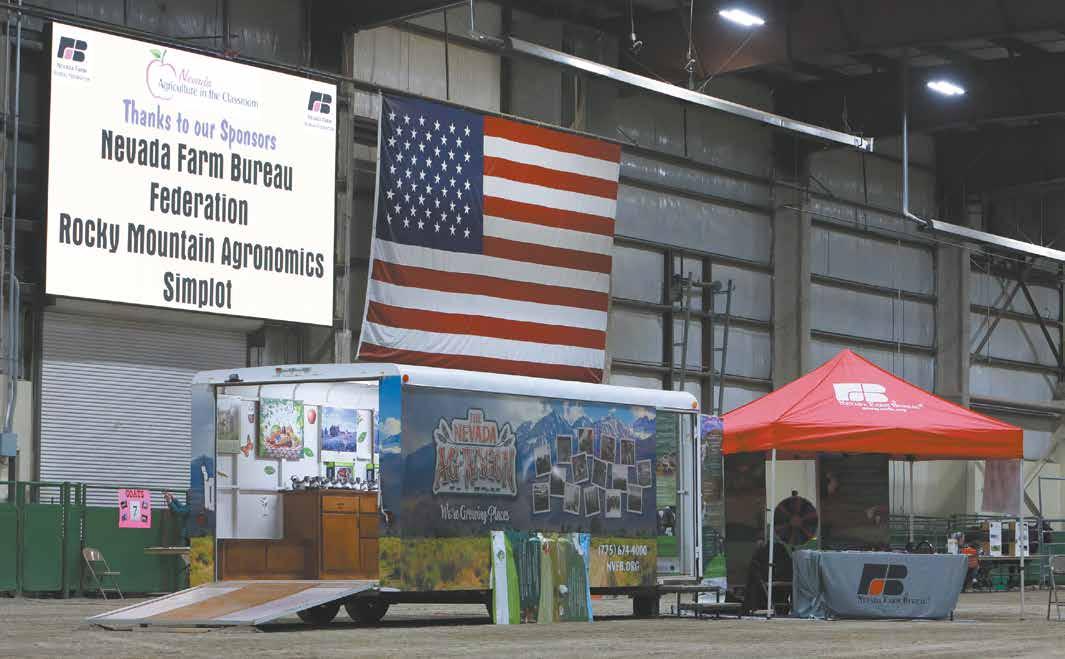
In addition to the trailer, we have also expanded the educational resources counties can request for Ag in the Classroom events. We have a variety of Ag magazine topics: snacks, pizza, ag innovation, pigs, corn, bees, careers, sheep, cows, dairy, specialty crops, food waste and entomology. We also have books teachers can read to younger kids with an included teacher guide: John Deere That’s Who, I love strawberries, How To Grow A Monster, Full Of Beans, Right This Very Minute, Barn at Night, Tales of the Dairy Godmother, Honeybee, How Did That Get In My Lunchbox and Sleep Tight Farm.
Another great resource available is the Nevada Agriculture and Water Educational Series the Nevada Ag Foundation has collaborated to create. This booklet has 5 lessons that align with Nevada 3rd-5th grade standards. Lesson cover topics from the history and importance of water to how agriculture is being conservation aware. The booklet also includes access to a Water & Agriculture Video series. This would be an ideal resource for Nevada Educators.
We have a lot of great resources available and look forward to working with counties to make their next event a great success. If you have any questions about resources available, please reach out to Woody at woody@nvfb.org.
Stay tuned as Nevada Ag Wagon travels across the state.
The Progressive Rancher www.progressiverancher.com MAY - JUNE 2023 21
THE ROUNDUP
An analysis of western ranching politics brought to you by the PLC RECENTLY,
IN WASHINGTON...
In Congress, Bipartisan Opposition to Conservation Rule Grows
Earlier this month, the Bureau of Land Management (BLM) published a proposed rule that signals a potentially drastic shift in multiple-use management across 245 million acres of land. The rule, now open for comment through June 20, has a purported intent to promote conservation and restoration across the West. Several of its primary mechanisms for accomplishing this aim — elevating conservation as a "use" under the Federal Land Policy and Management Act (FLPMA), establishing a conservation "leasing" system, and accelerating and expanding designations of Areas of Critical Environmental Concern (ACECs) - all pose a serious threat to multiple use.

PLC denounced the rule's most concerning aspects, citing both the substantive threat to multiple use and the poor process that resulted in the development of a major rulemaking without any communication with impacted stakeholders.
Some members of Congress were also quick to speak up when the rule was published. Across Congress, members have condemned the process and expressed concerns that the rule will compromise long-term management strategies and will be mechanism for extremist groups to reduce or eliminate multiple use.
The fact that the draft rule is already drawing bipartisan criticism, is notable. PLC is leading engagement with Congress for committees to provide oversight, and strong action from Congress will undoubtedly bolster PLC's position.
PLC will be leading industry comments as well as coordinating across a wide variety of multiple use groups. If you have questions, contact Kaitlynn Glover (kglover@beef.org).
DOI and USDA Tie Release of Old-Growth Forest Inventory to Climate Change Efforts
As part of today's recognition of Earth Day, this week the U.S. Department of Agriculture (USDA) and the Department of the Interior (DOI) released a new inventory of mature and old-growth forests across the country. In the roll-out of the inventory, the Biden Administration hinted at possible future rulemakings to more closely tie forest management to their climate change goals, but stopped short of proposing any specific changes to management at this time. Based on what has been said so far, it is clear that keeping pace with prescribed burning, grazing on forest lands, and other urgently-needed active management are not a priority for this Administraiton.
Takeaways from the inventory announcement include:
• The mature and old-growth inventory identifies more than 110 million acres of BLM and USFS forests that warrant, in the administration's view, specific protection because of their significance in fighting climate change.
• The administration has identified more than 2.3 million acres of public lands that are in need of reforestation.
• The vast majority of "old growth" forests are pinyon and juniper forests (approx. 9 million acres).
What
are the red flags for PLC?
Forests do indeed function as carbon storage, and therefore reduce the amount of carbon entering the atmosphere — but that is true no matter how old a forest is, or where it's located. The administration's focus on old-growth forests as somehow more ecologically valuable is cherry-picked science, and it encourages a patchwork management strategy that prioritizes famous and more-travelled forests and neglects active management in the backcountry.
A preservation approach is a guaranteed recipe for more frequent, intense, and widespread wildfires — and those fires release a massive amount of carbon, in addition to all the other environmental and economic harm inflicted on rural communities.
Last but not least, PLC has concerns about the specific focus on pinyon-juniper landscapes in the administration's discussion of conservation and reforestation. Pinyonjuniper encroachment gradually degrades and replaces sagebrush ecosystems by outcompeting native plant species, decreasing the soil water available, altering streamflow and surface water availability, and increasing fire risk. This encroachment harms many of the West's most iconic species that depend on the sagebrush biome, including the sage grouse and ungulates like pronghorn. Any restriction or repeal of the currently active, commonsense pinyon-juniper management in the name of forest conservation would be a massive mistake for Western lands.
With Debt Ceiling Looming, Busy Spring Continues on Capitol Hill
After the Easter recess, lawmakers are back in Washington and packing the schedule with more legislative and budget hearings.
Secretary of the Interior Deb Haaland has been on the Hill already this spring to answer for the department's FY24 budget request, but her hearing this week with the House Natural Resources Committee was her most contentious appearance yet. Chairman Westerman (R-AR) and other Republicans objected to many of the agency's actions to reduce oil and gas development on public lands, fast track renewable energy development, and roll back improvements to the ESA that were made under the previous administration.
On the other side of the Capitol, the Senate Energy & Natural Resources Committee questioned Forest Service Chief Randy Moore on the agency's budget request. Chairman Manchin (DWV) and others called out the agency for its continued and widespread staffing shortage. The committee also dug into implementation of the Bipartisan Infrastructure Law, and whether USFS has done enough — particularly under good neighbor authority — to get those dollars out the door.
While the window for appropriations requests has been closed for a couple weeks now, expect federal spending to remain under the microscope over the coming weeks.
What about the debt ceiling?
Even though there is no shortage of other work to be done, this is the fight that is sucking all the oxygen out of the room for congressional Republicans right now. The federal government hit its current borrowing limit of $31 trillion in January, triggering a scramble to avoid defaulting on our national debt. The government is facing default as early as June.
This week, Speaker McCarthy finally released a draft Republican proposal that he has said will not make it to President Biden's desk but will at least force Democrats to the negotiating table. The problem is that making it to the President is the least of McCarthy's hurdles, as his current proposal might not even make it out of the House.
McCarthy's current plan:
• Raise the debt ceiling by $1.5 trillion or suspend the limit until March 31, 2024, whichever one comes first.
• Cut federal spending to FY22 levels, a massive reduction of about $130 billion.
• Limit any future increases to federal agency budgets to 1%.
• Implement stricter work requirements for nutrition programs like SNAP and healthcare programs like Medicaid.
• Reverse the increase to the IRS budget that was included in the Inflation Reduction Act (IRA).
• Gut various other measures that have already been passed during the Biden Administration, such as environmental spending under the IRA and unspent dollars from the infrastructure package.
Republicans' concerns:
With opposition by every House Democrat guaranteed, he can only afford to lose four votes from House Republicans. The caucus has a variety of internal hurdles, including:
• Calls for stricter work requirements from the Freedom Caucus, the conservative hardliners who eventually budged to allow McCarthy to become Speaker (and who are now in a powerful position to make demands).
• Concern about forcing vulnerable Republicans to go on record backing such a severe proposal that's guaranteed to fail when the spending cuts will hand Democrats plenty of campaign ammunition in swing districts.
• Regional worries, with no one area of the country wanting to bear the brunt of spending cuts. For example, the current
The Progressive Rancher www.progressiverancher.com 22 MAY - JUNE 2023
provision to cut ethanol and biodiesel spending would disproportionately impact farm states in the Midwest.
Bottom line: McCarthy is up against very steep odds to rally his caucus behind a proposal that can pass his own chamber, the Senate, and secure President Biden's approval all before the United States defaults in early summer.
2023 PLC Grant Process NOW OPEN
On Tuesday, April 11, PLC began soliciting applications for FY24 grant awards related to strengthening public lands ranching. Research can be related to a number of topics, including:
• Comparative efficacies of prescribed grazing and prescribed fire in wildfire mitigation.
• Ecological, social, or economic impacts on federal lands ranching communities caused by from increased recreation or other changes in multiple use.
• Costs of implementation of the Endangered Species Act.
PLC awards grants for research to equip its staff with tools that will help the organization defend and advance the future of grazing on public lands. Through these grants, PLC works to improve conditions for those engaged in livestock grazing on public lands, improve industry products, and attain a higher degree of efficiency in the operation of PLC members’ businesses.
To view the full request for proposals, along with the grant application (due June 9), visit https://publiclandscouncil. org/wp-content/uploads/2023/04/
Final-RFP-FY2024.pdf
Join Our Team! Seeking an Associate Director of Operations
Join our team in Washington, DC!
The Public Lands Council is hiring an Associate Director of Operations to join the Washington, DC office. This role also supports and assists the PLC Executive Director in communicating with PLC affiliates and managing the day-to-day business operations, as well as managing annual grants, sponsor relationships, and more:
Works with PLC staff to prepare and distribute yearly PLC affiliate dues invoices, process officer and staff expense reports, and manage other financial transactions.
Assists in planning national PLC meetings including logistics, budget, sponsorships, and agenda.
Assists the PLC Executive Director with the administration of the Public Lands Endowment Trust, including communication and coordination with grantees to ensure contracts are executed timely.
Actively engages with PLC volunteer leadership to book travel, organize agendas, and engage with other planning tasks.
This is a shared position with the National Cattlemen’s Beef Association. Applications are OPEN! To learn more and apply, visit: https://www.linkedin. com/jobs/view/3550560676/
Weather Blast
With volatile weather conditions across the West, knowing what's coming next has never been more important. Our partners at AgRisk Advisors and WSR insurance want you to be able to plan for the (hopefully) greener days ahead with expert weather advice. Visit here to watch Weekly Weather Blast: www. youtube.com/watch?v=1Hz4MkzsiYM
Thank you to our exclusive insurance partners, AgRisk Advisors and WSR Insurance for supporting this important feature! Their support of our industry and of all of you is never more important than when Mother Nature makes your job so much harder!
Weekly Cattle Market Report
Friday Live Cattle
Contract: April 2023
Last: 175.60
Open: 175.78
High: 177.70
Low: 175.18
Change: +1.33
Volume: 5,045
Friday Feeder Cattle
Contract: April 2023
Last: 202.33
Open: 203.60
High: 204.00
Low: 202.25
Change: +0.10
Volume: 2,195
Weekly Sheep Market Summary
https://www.sheepusa.org/resourcesmarketreports
Nevada Farm Bureau Grassroots Newsletter
Small Farm Conference Rescheduled To August 25 & 26
Over the past several weeks we have been promoting the Small Farm Conference that has been planned for the Santa Fe Station Hotel and Casino in Las Vegas on May 5th and 6th. For those interested in participating, the conference has been rescheduled to August 25 and 26. We hope that those who are interested in being part of the workshops and meetings will continue to stay tuned… Mark your calendar for August 25 & 26!
The purpose for the conference is still to bring small acreage producers, nonprofits, farmers market coordinators, and various agencies together to network and to improve small scale agriculture throughout the state.
Money Related Bills Have Attention Focused on May 1st Economic Forum
A number of key water bills and other proposals involving spending are sitting in limbo of the Senate Finance Committee or the Assembly Ways and Means Committee. The due date of May 1st for the Economic Forum’s report will establish the amount of money available to spend. With these parameters established, the process will play itself out in figuring out what legislation gets funded as well as whether the requested amounts will be met. A priority for Nevada Farm Bureau and other water interests includes SB 176 a bill which seeks the establishment of a program for purchasing water rights from willing sellers and then retiring those water rights in order to bring about a correction to over-pumped basins. Other bills of interestwaiting for funding are: AB 109, SB 112, SB 244
Respond to Census Of Ag
Time is running out to respond to the Census of Ag! By not responding, producers risk being unrepresented and therefore underserved in farm programs and funding, crop insurance rates, rural development, disaster assistance, and more.
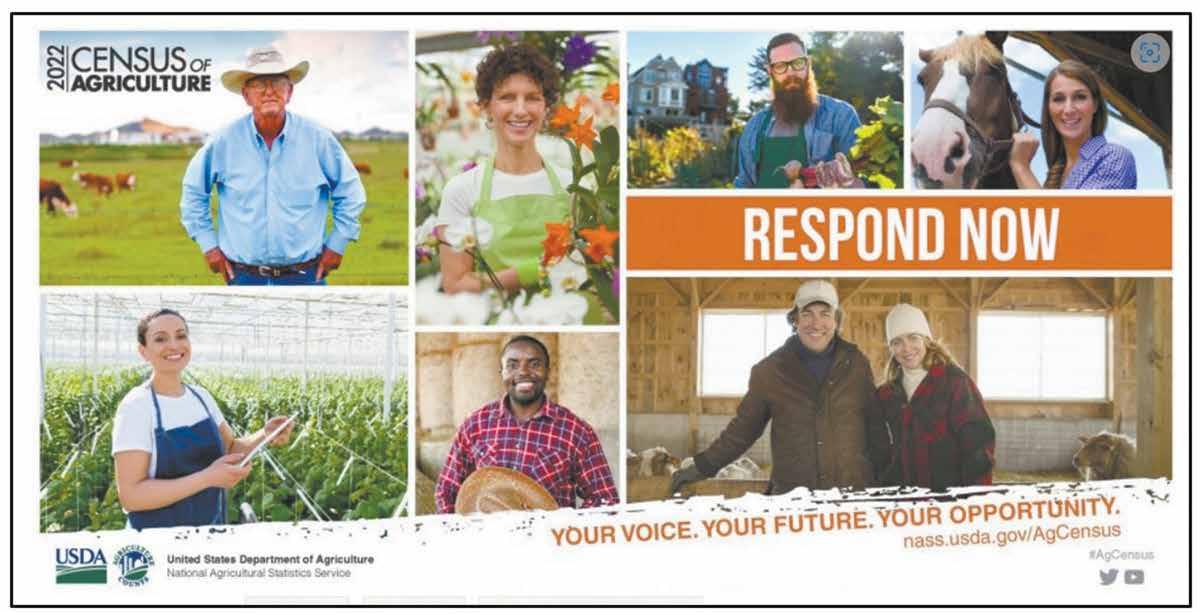
Thank you to the producers who have already taken the time to complete the census. As of April 25, the USDA National Agricultural Statistics Service (NASS) received more than 1.47 million completed census forms from producers across the nation. That’s nearly 53% and growing. NASS will continue to collect census questionnaires through the spring to ensure the best possible representation in the data.
By federal law, the ag census questionnaire needs to be completed by everyone who received it, including landowners who lease land to producers, those involved in conservation programs, even those who may have received the ag census and did not farm in 2022. The ag census is long because it covers nearly every aspect of American agriculture just once every five years. As such though, producers only respond to what pertains to their operations so, for the vast majority, they will not answer the entire questionnaire. The questions in the ag census are detailed because they paint the whole picture, not just commodity production but the very structure and economic health of the industry. To best serve producers, the hardworking folks who provide for so many, we need to be able to quantify, for example, if current farm programs are meeting needs, if producers are losing money, etc.
Also required by federal law, NASS keeps all submissions confidential and uses the information for statistical purposes only.
The Progressive Rancher www.progressiverancher.com MAY - JUNE 2023 23
THE PRESIDENT'S PUBLICATION
Mark Roeber, President, PLC
After three years, it feels good to say that we just wrapped up a successful in-person Legislative Conference. When we last got together in Washington, DC, it was 2019 and the world looked a lot different.
More than 75 ranchers met in DC on April 24 to talk about some hard issues and to plan for the future. There's no question that we have some hard times ahead. There's a clear attitude from the federal agencies that they're moving full steam ahead with a whole pile of regulations that will be harmful for all of us in rural communities. That, combined with the feeling that everyone in Washington seems to be waiting on some court case or another before they to make any decisions means that the times will require all of us to be pulling in the same direction.
Last week's meeting takeaways included: Beware of anyone talking about "once in a generation" opportunities, investments, or changes. They're likely taking a run at something that has been tried before and failed for good reason. That, or it's unreasonably expensive.
You've got to know the process inside and out. With the BLM's latest proposed rule on conservation, the agency is using all tools in their toolbox to expedite the process right past invested stakeholders like ranchers. The same process that should make sure we're included is being used to keep us quiet.
Whenever anyone tells you it's too good to be true, it probably is. That goes for horses, pickups, and legislation. Congress is looking for examples. PLC staff are always reaching out for examples of how policies impact real people. Be one of those people and speak up or continue to be one of the people who is impacted quietly.
If someone, especially a federal agency, tells you they just need more money to fix a problem, that's almost never the truth. They get the money, and then they need more manpower to figure out how to spend it.
It may be easier to walk away, but that's never the solution. Last week, several agencies told us that if we felt like we needed to walk away from our engagement on an issue, they'd understand. That's the exact wrong approach to take. If you're not at the table, you're on the menu. It may be easier for the agencies if we pull back but the industry today and our children's industry would suffer.
Last week, I was encouraged to see so many new faces join us to put boots on the Hill but I know many of them left DC as concerned about the future as I am. The best thing you can do now is to make sure that you are involved. Voices carry, especially when the truth and the law are on their side.
LEGISLATIVE CONFERENCE RECAP
On April 24, federal grazing permittees gathered in Washington, D.C. for a full day of advocacy, education, and policy discussions with agency leadership and congressional staff.
PLC successfully returned to an inperson, fly-in event with important speakers from the Biden Administration agencies that most directly affect Western ranchers. In the morning, attendees heard directly from BLM Director Tracy StoneManning, U.S. Fish and Wildlife Service Deputy Director Siva Sundaresan, Forest Service Deputy Chief Chris French, and USDA Wildlife Services Deputy Assistant Administrator Jessica Fantinato. Additionally, senior staffers from the Senate Energy & Natural Resources Committee, House Natural Resources Committee, and Senate and House Agriculture Committees briefed attendees in the afternoon on upcoming natural resources legislation and ongoing Farm Bill negotiations.
Equipped with this perspective from both the executive and legislative sides of government, PLC permittees hit the ground running on April 25 and 26.
Alongside more than 250 members of the National Cattlemen's Beef Association, PLC attendees met with dozens of members of Congress and five different federal agencies. These meetings were incredibly valuable opportunities to lobby decisionmakers directly and advocate for policies that support public lands ranching.

Last but certainly not least, Team Lamb was crowned the winner after the longawaited return of the Best of the West Cook Off. Congratulations!
We were thrilled to see everyone back in our nation's capital, and we look forward to welcoming more of you in 2024.
FROM THE THE EXECUTIVE DIRECTOR
Kaitlynn Glover, Executive Director, PLC kglover@beef.org
They say April showers bring May flowers, and while there's been plenty of rain in Washington, DC, I think the origin of that phrase is probably much more suited for regulatory weeds than beautiful blooms.
This month saw the BLM propose a complete overhaul of the agency's interpretation of the multiple use mandate, USFWS reopen a comment period in the listing process for the Bi-state sage grouse population, and more press releases than I can count from the administration on random acts of "conservation" that more closely resemble "recreation" than "conservation".
It would be easy to look at the year ahead with a degree of skepticism, but April's Legislative Conference proved that in lobbying, there's no substitute for real, personal stories and constituent outreach when advancing priorities (or beating back the worst kind of bureaucracy). This month, you're hearing from Mark, Sigrid, and myself that now is not the time to take your eyes off the ball. Over the past 3 weeks, PLC has briefed more than 50 Members of Congress about the BLM 's poorly devised conservation rule, wild horse and burro issues, wildfire issues, and more. These conversations help Members of Congress to think strategically about what the year should look like, from setting sideboards on the administration's ability to use funds for land acquisition to enacting meaningful changes in the way the agencies conduct post-fire remediation. It's easy for Washington to get stuck in the same, tired old talking points. It's not so easy when those talking points have a face, a story, a name, and an address.
I offer my thanks to each and every rancher who traveled to DC to lend their story to each of the issues in PLC's 2023 Policy Book, and ask you to keep at it. The BLM has proposed one of the most dangerous changes to multiple-use management I have ever seen, and we're going to need each and every one of you to help us prevent the proposed rule from being finalized in this form.
Read more below, and remember this: public lands ranching's place on the landscape is secure, but it requires defending every single day. From the halls of every federal agency to the places you can't reach except by horseback, I appreciate all you do to protect this way of life.
POLICY SPOTLIGHT
Sigrid Johannes, Director, PLC sjohannes@beef.org
The month of April was a timely and forceful reminder of the importance of PLC's partnerships, both in Washington and across the West.
During our legislative conference, PLC capitalized on our partnership with NCBA to triple the number of voices taking our message to Capitol Hill. Cattle producers who had never set foot West of the Mississippi became federal lands grazing advocates, helping to amplify PLC's positions on everything from sage grouse to wildfire. This extra manpower was invaluable, as our attendees covered meetings with both House and Senate lawmakers from all 14 PLC states in just two days, in addition to the Bureau of Land Management, U.S. Forest Service, U.S. Fish and Wildlife Service, USDA Agricultural Marketing Service, and Environmental Protection Agency. While PLC has decades of experience being the only group in Washington solely dedicated to advocating for public lands ranchers, we also know the value of strength in numbers — particularly when it comes to serious threats like the new BLM lands rule.
The next few months are going to pile up with deadlines and regulatory actions on many of the Biden Administration initiatives that have the potential to severely undermine your operation — including the lands rule, grazing regs, and sage grouse plans. Now is not the time to disengage! Stay up to date on how PLC is getting involved in each of these processes, and reach out if you have questions. Thank you.
BLM'S LATEST PROPOSED RULE PROMISES "CONSERVATION" BUT WILL COMPROMISE LAND HEALTH
On April 3, the BLM published the text of the Conservation and Land Health proposed rule. Despite receiving no stakeholder input - or even review - prior to publication, the BLM has defended the proposed rule as transformational for the way the agency will be able to conduct conservation on federal lands.
PLC agrees the proposed rule would be transformational, but not in the way the BLM has offered. It would cripple the agency's multiple use mandate and plunge the agency further down the road of ineffective, fragmented acts of "conservation" rather than meaningful, coordinated strategies that promote range resiliency rather than single-use objectives.
A collection of monthly updates from public lands council leadership and staff
The Progressive Rancher www.progressiverancher.com 24 MAY - JUNE 2023
Attendees at Legislative Conference heard from BLM Director Tracy StoneManning about the rule. The BLM has proposed to elevate conservation as a new "use" under the Federal Land Management and Policy Act (FLPMA) in order to give themselves authority to lease BLM land for conservation activities. By doing this, the BLM has given themselves the ability to hand over veto power to anyone who could hold a conservation lease when it comes to multiple use decisions. The proposed rule says multiple uses could only be authorized only if they don't conflict with an existing conservation lease, giving the lease and lease holder a power that no other user of federal land has. With a poorly-defined and inappropriately narrow definition of "conservation", the BLM has made the proposed rule simply unworkable.
PLC is already leading the charge against the proposed rule. The BLM chosepoorly - to leave public lands ranchers out of the conversation loop ahead of publication. That choice is evident in the poorly constructed, ill-advised contents. PLC is leading industry comments, convening multiple use groups who would be harmed by the proposed rule (everyone

from grazers to mountain bikers, counties to bird watchers), and supporting Members of Congress who have their own concerns with the BLM's disregard for Congressional direction in FLPMA. What can you do? Contact your Senator or Representative today and tell them to oppose the BLM rule and hold the agency accountable. Contact PLC to be involved in the comment process. Develop comments ahead of the June 20th deadline, and keep your eyes open for the public meetings that will be announced soon.
Want to learn more about PLC's strategy ahead of the June 20th deadline? Contact Kaitlynn Glover at kglover@beef.org for talking points and next steps.
CONGRESSIONAL COMMITTEES CONDUCT AGENCY BUDGET OVERSIGHT
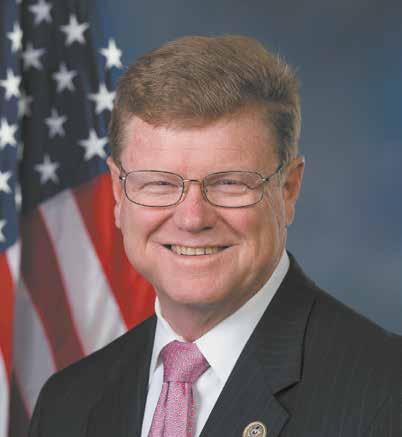
On April 26, the House Committee on Natural Resources held a hearing titled "Examining the President's FY 2024 Budget Request for the U.S. Forest Service". The Chief of the U.S. Forest Service (USFS), Randy Moore, served as a witness for the hearing, providing an outline of the fiscal needs of the forest service for the upcoming year. The hearing
proved somewhat contentious: Chairman Bruce Westerman (R-AK), in his opening remarks, emphasized the fact that despite millions of dollars of funding authorized by Democratic legislators in recent years, USFS has continuously failed to streamline the regulatory procedures associated with active forest management. By contrast, Democratic legislators repeatedly attacked their Republican counterparts throughout the hearing for their reluctance to adequately fund USFS and their inability to recognize the severity of the "climate crisis" - despite historic Congressional investments over the last 2 years in USDA and USFS programs.
Tensions remained high as GOP members stressed the need for more efficient spending amidst a backdrop of anticipated cuts through a future appropriations package. Chief Moore's budget proposal outlines an increase of $2.6 billion in overall USFS spending from FY2023 levels, bringing the overall FY2024 USFS budget to $9.7 billion. Democratic representatives, by contrast, emphasized the catastrophic toll that wildfires have taken on communities around the nation, stressing that the overall savings from wildfire mitigation
and prevention fueled by the increased spending in the USFS's FY2024 budget proposal outweigh the aforementioned discretionary spending increase. Amidst the partisan contention, PLC staff remain committed to advocating on behalf of public lands ranchers throughout the appropriations process to ensure that America's public lands stewards get the funding they need - and that funds are allocated to rangeland health programs, not just the timber programs.
As the month continued, the Senate Energy and Natural Resources Committee posed similar questions to USFS Chief Moore and is anticipated to be prepping hard questions for Interior Secretary Haaland, particularly as the Department oversees the BLM's poorly conceived Conservation and Land Health rule.
STOP LOCKING UP OUR LANDS PRESIDENT BIDEN!
Congressional Western Caucus Podcast Listen here: https://podcasters.spotify.com/pod/show/ chairman-dan-newhouse/episodes/StopLocking-Up-Our-Lands--President-Bidene234d0b/a-a9o673v
NEWS RELEASE
Amodei Votes Yes on Limit, Save, Grow Act of 2023
Congressman Mark Amodei (NV-02) made the following statement after voting for the Limit, Save, Grow Act of 2023, legislation to lift the debt ceiling into next year as well as limit Washington’s irresponsible spending, save taxpayer dollars, and grow the economy.
“Our national debt is at an all-time high, exacerbated by two years of the President’s reckless spending sprees. We are now faced with the following choice: kick the can further down the road at the expense of future generations or make smart financial decisions now. I choose now.
“As a fiscal conservative, I believe that raising the debt ceiling must be done in conjunction with measures to cut political agenda spending. That’s why I am pleased to support the first step in returning to sanity - legislation that will limit spending, save taxpayers trillions of dollars, grow our economy, and lift the debt limit into next year.
“As usual, rather than working with the House majority on a reasonable solution to our nation’s debt crisis, President Biden’s handlers along with Senator Schumer have demanded that Congress raise the debt ceiling without implementing any changes to how the government spends and borrows trillions of dollars.
“The status quo is unreasonable and irresponsible. An increase in the debt limit without spending controls would only schedule another debt crisis on the American people’s calendar.
“Now that the House majority has delivered on responsible debt ceiling legislation, it’s time for Senator Schumer and President Biden to put partisan brinkmanship aside and act like political adults instead of playground rock throwers.”
The Limit, Save, and Grow Act includes the following provisions: Return FY24 non-defense discretionary spending to FY22 levels.
· Rescind unspent COVID money. Prohibit Biden’s student loan forgiveness proposal. Repeal some ‘Green New Deal’ tax credits.
Eliminate funding for the 87,000 new IRS agents charged with shaking down families and small businesses.
· Restore work requirements to lift Americans out of poverty. Enact H.R. 1 to lower energy costs. Responsibly lift the debt limit through March 31, 2024, or by $1.5 trillion.
The Progressive Rancher www.progressiverancher.com MAY - JUNE 2023 25
Farm to Fork Certification Program provides information on livestock production and processing Program offers course for new or up-andcoming Nevada livestock producers
The University of Nevada, Reno Extension’s Herds & Harvest Program is hosting a Farm to Fork Certification Program, 6 – 8 p.m., Wednesdays, April 19 – May 17. The courses in this program will offer information for beginning farmers and ranchers on the process of livestock and poultry production, from raising livestock to selling the products on the market.
The program’s courses will be conducted via Zoom and will draw upon the knowledge and experience of established Nevada livestock and poultry producers and University experts. There will also be an in-person field trip touring local farms and ranches. Participants who complete the course will receive their Farm to Fork Level 1 Certification. Course topics include:

• April 19: Overview of Farm to Fork for livestock production: focusing on jurisdictions and regulations existing in Nevada, livestock production for local consumption, developing a business plan, public and private land grazing, and identifying resources.

• April 26: Livestock nutrition and reproduction: focusing on the basics of livestock nutrition, feed management, reproduction and characteristics of meat based on nutritional management.
• May 3: Poultry nutrition and reproduction: focusing on the basics of poultry nutrition, feed management, reproduction and characteristics of meat based on nutritional management.
• May 10: Defining grow local and developing marketing plans: focusing on developing a grow-local product, creating a marketing plan and how to sell a local product.
• May 17: Farm financial management in the 21st century: focusing on financially building a farm, building business skills and assets, estate planning, and balance and cash flow basics. University students will provide financial analysis of different agricultural ventures.
• Field trip dates announced upon registration: Field trips to tour local farms and ranches. Participants can choose which one of the two tours they wish to take, according to their location and interests.
The cost for the program is $60 per person, and registration can be completed online at https://BFRfarmtofork1.eventbrite.com
For more information, contact Staci Emm, Extension educator for Mineral County, at emms@unr.edu or 775-475-4227; Kaley Chapin, outreach specialist, at kaleys@unr.edu or 702-467-2668; or Jamie Lee, program officer, at jamielee1@unr.edu or 775-426-8299.
Persons in need of special accommodations or assistance should contact Paul Lessick, civil rights and compliance coordinator, at plessick@unr. edu or 702-257-5577 at least five days prior to the scheduled event with their needs or for more information.
The Extension Herds & Harvest Program combines a series of workshops on different topics and provides educational business management and mentoring skill building to support Nevada agricultural producers. This project was supported by the Beginning Farmer and Rancher Development Program of the National Institute of Food and Agriculture.
H erds & H arvest About
The Nevada Herds & Harvest program combines a series of workshops on different topics, and provides educational business management and mentoring skill building to support Nevada agricultural producers. If you are interested in meeting with a mentor to build a specific enterprise budget for your agricultural operation, please contact the faculty member below to begin your mentoring experience.
How to Register...
Visit: https://BFRfarmtofork1.eventbrite.com
For additional information contact:
Kaley Chapin Outreach Specialist
Phone: (702) 467-2668 kaleys@unr.edu
Jamie Lee Program Officer Phone: (775) 426-8299 jamielee1@unr.edu
Mineral County Extension P.O. Box 810 Hawthorne, NV 89415
Cost: $60 per person, handouts and snacks provided.
Persons in need of special accommodations or assistance must call or notify Kaley Chapin at 702-467-2668. This program was funded by the USDA, National Institute of Food and Agriculture.
This project was supported by the Beginning Farmer and Rancher Development Program of the National Institute of Food and Agriculture, USDA Grant # 2020-49400-32321. To find more resources and programs for beginning farmers and ranchers please visit www.Start2Farm.gov, a component of the Beginning Farmer and Rancher Development program.
The Progressive Rancher www.progressiverancher.com 26 MAY - JUNE 2023
2023 Course Outline
BFR Farm to Fork Certification Programs
Certification I

This program will be a hybrid model of education utilizing Zoom and personal connections in Nevada agriculture. The field trip will be mandatory in order to receive your Level 1 Certification. Each online course will be up to 2 hours long with breaks. The course outline is below:
April 19, 2023 6 to 8 p.m.
Last week our team at the Nevada Department of Agriculture (NDA) enjoyed spending time with legislators and their staff during Agriculture Day at the Legislature. Staff from each of our divisions shared program information along with the various impacts agriculture has on our state. We appreciate the opportunity to talk directly with legislators about the work we’ve done to aid the community and increase food access – from our Home Feeds Nevada program to the building of our Nevada Meat and Poultry Inspection program. NDA staff works hard to address issues and strengthen Nevada’s food systems. A huge thank you to everyone who took time out of their day to attend our Legislature Day.
- Director Goicoechea
Course 1 via Zoom: Overview of Farm to Fork for livestock production including jurisdictions and regulations existing in Nevada. This course will not only introduce livestock production for local consumption, it will also provide the basics for beginning to develop your business plan for your own operations, understanding public and private land grazing, and identifying your resources.
Assistance available for farmers and ranchers affected by winter storms
The NDA is working with the USDA Farm Service Agency (FSA) to bring assistance to producers impacted by winter weather and flooding. Different programs are available for different types of loss. It is imperative that producers maintain records of all types of losses, as records will be needed for many assistance applications. Any producer who has experienced any level of loss (loss to livestock or crop, structure failure, challenges accessing or purchasing feed, etc.) is encouraged to report to their local FSA offices. For any losses going forward, it should be reported within 30 days. Reports can be made via phone call, email, or by walking into a local office. Find contact and location information for the nearest FSA office at farmers.gov/ service-center-locator.
Association’s (WUSATA) inbound trade mission to Nevada for healthy, natural, consumer-oriented products. During the event the Fallon based supplier met with five different buyers from Mexico. They promoted their ‘seed-to-shelf’ teff and sorghum products during the mission and gained great interest from buyers. Since then, Desert Oasis Teff & Grain has been exporting to Mexico, building relationships with buyers in that market. The NDA trade and economic development team offers an array of resources to Nevada agriculture, food or beverage companies interested in exporting like Desert Oasis Teff & Grain, along with assistance ranging from domestic and international marketing, customized one-on-one international market research, export training and education, trade and economic reports, and trade show/trade mission support. These opportunities are funded through state funding, partnerships, and state and federal grants. For more information, visit agri.nv.gov/economic_development or email nvtrade@agri.nv.gov to get started.
Have you filled out the 2023 Ag Census yet?
May 3, 2023 6 to 8 p.m.
Course 3 via Zoom: Poultry Nutrition and Reproduction will focus on the basics of poultry nutrition, feed management, reproduction, and characteristics of meat based on nutritional management.
Instructors: Amilton de’Mello, Associate Professor, CABNR, UNR; and other instructors to be determined.
The USDA is still collecting responses for the 2022 Census of Agriculture here: https://www.nass.usda.gov/AgCensus/ index.php The Census allows producers to tell the story of U.S. agriculture and is a valuable factor in determining resources that will be made available to producers in Nevada. Census data informs decisions about policy, farm and conservation programs, infrastructure and rural development, research, education, and more. USDA will continue to collect completed 2022 Ag Census forms through the Spring to ensure all producers have the chance the be represented in widely used census data. Producers can respond online at agcounts.usda.gov or by mail.
Find pesticide applicators
May 10, 2023 6 to 8 p.m.
Course 4 via Zoom: Defining Grow Local and Developing Marketing Plans will focus on developing a grow local product, how to create your marketing plan, and the opportunities of how to sell a local product.
Home Feeds Nevada seeking producers — APPLY TODAY!
Instructors: Staci Emm, Mineral County Extension Educator, UNR; and other instructors to be determined.
Report Mormon Crickets
As the weather warms in northern Nevada Mormon Crickets may begin to emerge. These insects can cause damage to agriculture and are a public safety risk on roads. Please report sightings of Mormon Crickets with this form, or by emailing the address or coordinates of crickets to jknight@agri.nv.gov.
Help collect food insecurity data
Instructors: Kaley Chapin, Program Outreach Specialist, Mineral County Extension, UNR; Staci Emm, Mineral County Extension Educator, UNR; and Brad Schultz, Professor and Humboldt County Extension Educator, UNR.
April 26, 2023 6 to 8 p.m.
The NDA is looking for Nevada agricultural producers to apply for the Home Feeds Nevada Agriculture Food Purchase program. Through this program, the NDA will purchase nutritious foods that are grown, produced or processed in Nevada and distribute them through designated food banks. Program details and requirements for eligibility are outlined in the Request for Qualifications (RFQ) https://tinyurl.com/RFQ-NDA

May 17, 2023 6 to 8 p.m.
As we look towards Spring and warmer weather, insects and pests are more likely to find their way inside your home. Remember you must hire a licensed professional to spray your home as the misuse of pesticides can have critical consequences to the user, public and the environment. Here's a list of licensed pest companies: agri.nv.gov/uploadedFiles/ agrinvgov/Content/Plant/PEST/ Website%20License%20Report(1).pdf
Start stamping with your 2023 Nevada Craft Beverage Passport

Course 5 via Zoom: Farm Financial Management in the Twenty-First Century will focus on financially building your farm, building business skills and assets, estate planning, and balance and cash flow basics. UNR students will provide financial analysis of different agricultural ventures.
Questions or comments regarding this program should be directed to Patricia Hoppe at pxhoppe@agri.nv.gov.
Course 2 via Zoom: Livestock Nutrition and Reproduction will focus on the basics of livestock nutrition, feed management, reproduction, and characteristics of meat based on nutritional management.
Instructors: Mozart Fonseca, Associate Professor, CABNR, UNR; Luis Fernando Schutz, Assistant Professor, CABNR, UNR; and Amilton de’Mello, Associate Professor, CABNR, UNR.
In addition, the Biden Administration has issued a major disaster declaration for several counties in Nevada impacted by adverse weather and flooding. The NDA will send out updates as more information and resources become available.
First-time sale to Mexico for Nevada Teff Company
In November of 2021, Desert Oasis Teff & Grain participated in the Western United States Agricultural Trade
Be Aware of Invasive Plants, Pests and Disease
Instructors: Tom Harris, Professor of Economics, UNR; Kelly Barnes, Vice President Lending, American AgCredit; and UNR Business Students.
Celebrate the spring season with your own 2023 NV Craft Beverage Passport! With every visit to a local Nevada establishment on the Passport, participants receive a stamp – the more stamps you get, the bigger the prize. From Lovelock to Boulder City, check out some awardwinning brewed, distilled or fermented beverages for anyone 21 and older to enjoy. https://agri.nv.gov/passport/
The NDA is seeking to partner with a Nevada-based organization to develop a data collection methodology to track food insecurity. The NDA has allocated $475,000 for this project and intends to partner with a for-profit, non-profit, or publicly owned organization/company with proven experience developing research and data collection. Learn more about the program and apply by May 25 on the NDA website.
Funding opportunities
• USDA Rural Development announced investment funds to help rural Nevada businesses. Microloans for small businesses and entrepreneurs will be administered through the Nevada Development Corporation.
• USDA Farm Service Agency resources – relief programs have been extended and are available for producers experiencing challenges due to adverse weather, flooding and drought:
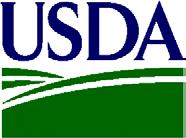
Emergency Assistance for Livestock, Honeybees and Farm-raised Fish Program (ELAP) – offering livestock and feed hauling cost assistance
Emergency Conservation Program (ECP) Emergency Farm loans

Non-native plant pests can hitchhike in untreated firewood, attach themselves to cars, boats, and other outdoor surfaces, or take a ride in the mail. They can travel to new areas on agricultural material such as soil, seeds, homegrown produce and plants. In Nevada, be aware of the following pests: Red Imported Fire Ant, Emerald Ash Borer, Gypsy Moth, Japanese Beetle, Red Palm Mite, Spotted Lantern Fly, Asian Longhorned Beetle. Invasive pests can quickly outpace native species and such pests, plants and diseases can disrupt our ecosystems and reduce biological diversity. To learn more about them and how to stop them, visit HungryPests.com.
Dates To Be Announced Upon Registration
Nevada Native Seed Forum educates on the need for seed and how to
grow it
Field Trip in Person: Tour of farms and ranches –tour stop focus will depend on attendee interest and location– in person. ** Must attend a tour and a Business Plan Review to receive a completion certificate.
The 7th Annual NV Native Seed Forum hosted attendees from around the US bringing together producers, agency partners, and others from around the native seed industry to discuss issues surrounding the industry and foster new connections. This year's speakers presented information on native cultivars, farming practices, government contracts, crop insurance and seed selling opportunities all focused on native seed production. You can watch the entire forum here: https:// youtu.be/2QsB3UzN6GU
To attend next year, contact Stephen Kielius at skielius@agri.nv.gov.
Emergency Livestock Relief Program (ELRP) Emergency Relief Program (ERP) Livestock Forage Disaster Program (LFP) Livestock Indemnity Program (LIP) Non-Insured Crop Disaster Assistance Program (NAP)
• USDA launched a new website, www. usda.gov/meat to communicate open and pending programs focused on expanding meat and poultry processing capacity.
• USDA announced the Food Supply Chain Guaranteed Loan Program (www.rd.usda.gov/food-supply-chainguaranteed-loans) to strengthen critical middle of the supply chain activities such as aggregation, processing (including meat), manufacturing, storage, transportation, wholesale or distribution of food. Interested borrowers can work with their own lender. Applications from lenders are accepted until funds are expended.
Copyright © 2023 University of Nevada Cooperative Extension – An EEO/AA institution
The Progressive Rancher www.progressiverancher.com MAY - JUNE 2023 27


The Progressive Rancher www.progressiverancher.com 28 MAY - JUNE 2023
Protect horses against West Nile Virus ahead of mosquito season
The NDA monitors West Nile Virus for the protection of public health
The Nevada Department of Agriculture (NDA) reminds horse owners in Nevada of the importance of vaccinating against West Nile Virus (WNV). This mosquito-borne disease can cause serious illness targeting a horse’s brain, spinal cord and nervous system. The disease can also be transmitted to humans from infected mosquitos. The NDA monitors WNV and other diseases carried by mosquitos throughout the state to ensure the protection of public health and the agriculture industry.
“The NDA tests sample pools of mosquitos throughout Nevada to monitor for diseases like WNV,” Laura Morrow, ADL Supervisor, said. “The Animal Disease Laboratory surveys and tests for these diseases and reports the
results to local health departments and vector control agencies.”
Taking precautions such as using insect repellents, eliminating mosquito-breeding sites including standing water, and keeping horses vaccinated against WNV and Equine Encephalitis is strongly encouraged for all horse owners.
NDA Director J.J Goicoechea, DVM, encourages horse owners to work with their veterinarian to develop effective management plan, which should include vaccination of animals. Timely vaccination and decreasing possible exposure to mosquitos is an effective way to prevent mosquito-borne diseases.
“Eliminating unnecessary standing water around barns and residences along with the use of deterrents can help keep mosquitos away from people and animals,” said NDA Director Goicoechea.
WNV and Equine Encephalitis have been detected in Nevada, and can cause significant illness and death in both horses and humans. WNV and Equine Encephalitis are reportable diseases in Nevada meaning that detections must be reported to the NDA.
Churchill County Work Based Learning advisory committee met on April 19 by Sue
Segura
The Churchill County Work Based Learning advisory committee advisory committee met on April 19. The meeting had representation from various stakeholders including the Governor's office, county, school board, staff, and community businesses. This is a collaborative effort to improve the work based learning and business community.
The Goals Established
1. Incorporating soft skills this is a valuable initiative as it can help students develop important interpersonal and communication skills that are essential for success in the workplace.
2. Encouraging reflection, as the second goal, is also a great way to help students develop critical thinking skills, which are important for problem solving and decision-making.
3. Real-life internships, as the third goal, can provide students with valuable work experience and exposure to different career paths.

4. Increasing technology and offering extra-curricular activities are also important goals as they can help students develop skills that are relevant to the current job market and help them explore different interests and passions.
Horrified at the increasing acts of violence on school grounds, founder of Secure Exits, Melinda Mort, took it upon herself to find a solution. As a teacher herself, Melinda knew there must be a better way to help and support both staff and students when faced with a lockdown or emergency situation on campus. With a pen and paper, she got to work on her first prototype. What she created was the Secure Exit Shade, a classroom door window cover that provides the peace of mind personnel need when faced with protecting themselves and others in life-threatening situations.
This now patented Secure Exit Shade is designed to cover most standard classroom windows. Secure Exit Shade completely obscures the classroom from the outside. Instructions on the inside of the shade support the personnel or teachers in using the four-color wheel and communicating emergency personnel the status of their classroom.


The Secure Exit Shade is a powder coated metal shade that is bolted to the door and is folded up during regular teaching hours, so schools can remain in compliance and ensure a positive learning environment for both students and staff.

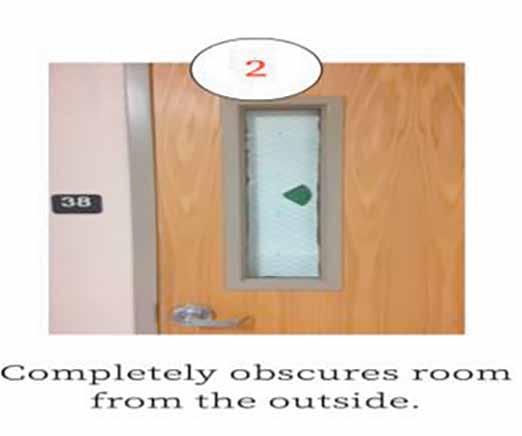
The Secure Exit Shade is a reliable, safe, and extremely easy solution to today’s growing violence on school grounds. The Secure Exit Shade can save up to ten minutes in an emergency. Teachers like Melinda no longer must spend valuable time searching for paper to cover the windows during emergencies.
For more information on the Secure Exit Shade, please visit www.secureexits.com.
The Progressive Rancher www.progressiverancher.com MAY - JUNE 2023 29
Graze Yearlings1500 on a 130 Acre Pivot for 30 Days
3.5 lbs. of Gain Per Day (69% TDN) 5-7 wt. Cattle*
Greenway Seeds Grazing Corn (GX80) is the No. 1 grazing corn in the nation because it is 5-6 days earlier than the competition. This allows the rancher to plant 5-6 days later and still reach peak sugar content (pre tassel) before the frost shuts you down!

OVERSEED ALFALFA
with Grazing Corn
Plant with a grain drill following second cutting on an older field alfalfa. Ready to graze in early September. “We planted GX80 following second cut alfalfa. If we had to do that over we would follow third cut. We grazed 400 head for two weeks on 20 acres” Cory Veterre - Greenriver, Utah
HERE’S WHAT RANCHERS ARE SAYING
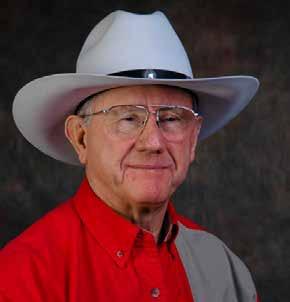
Casey Calvin - Monte Vista, CO
We grazed lambs on GX80. They ate it all the way to the ground. Unbelievable! (See website for photos)
Crawford Cattle - Winnemucca, NV
Planted mid July, it was way over our heads. We were surprised as to how long we were able to graze. We also baled some of it. We’re buying again.
Roberti Ranches - Loyalton, CA
We grazed pairs. They ate it all to the ground. We also baled it. The cows like it. We plant GX80 every year.
Coffin Butte Farm and Ranch - New Leitzigg, ND
We planted 400 acres on dryland and fed out 800 pair. We grazed it from Oct 20 to Nov 24. The corn was 7-1/2 ft. tall. The program was a success!
Over 50 years
Experience
GREENWAY’S
GRAZING CORN
Alan Greenway Seedsman
Greenway Seeds Caldwell, Idaho www.greenwayseed.com Alan cell: 208-250-0159 Message: 208-454-8342
* Jesse Norcutt, Currant, NV
The Progressive Rancher www.progressiverancher.com 30 MAY - JUNE 2023
28 Ton Silage Pasco, WA
Senator Cortez Masto drafts bill that would counteract Mining Law ruling
A Nevada Democratic U.S. senator is looking to Congress to ensure mining companies can use established mineral claims to dump waste on neighboring federal lands as they always had before a federal appeals court adopted a stricter interpretation of a 150-year-old law.
Environmentalists widely praised the 9th U.S. Circuit Court of Appeals’ more restrictive ruling, which blocked the Rosemont copper mine in southern Arizona last year because the company hadn’t proven it had mineral rights on the adjacent land where the waste rock was to be buried.
The ramifications of the ruling are worrisome, however, for President Joe Biden’s clean energy agenda and for key projects to mine lithium, cobalt and other materials needed to manufacture batteries for electric vehicles.
In response, Nevada U.S. Sen. Catherine Cortez Masto drafted a bill she intends to introduce Tuesday with Republican Sen. James Risch of Idaho, her office told The Associated Press on Monday. The bill would amend a 1993 budget reconciliation act but primarily clarifies definitions of activities and rights central to the 1872 Mining Law. The language is intended to insulate mines from the more onerous and likely most expensive standards imposed on the industry by the 9th Circuit ruling, which was a significant departure from long-established mining practices that environmentalists have fought for decades.
Two U.S. judges in Nevada have since enforced it — one in a complicated way that nevertheless allowed construction to begin at what would be the largest lithium mine in the nation near the Oregon line. Without congressional action, Cortez and other senators say critical mineral projects across the West are threatened, including those needed to expedite the transition from fossil fuels to renewable energy and to bolster national defense.
“This misguided decision would force all mining activities, even the storage of waste, to happen on mineral-rich land, which could impede critical mineral production all across the country,” Cortez Masto said in a statement emailed to AP.
Nevada is the biggest gold-producing state and home to some of the nation’s largest lithium deposits.
independent, have signed on to the bill as co-sponsors.
The measure is sure to meet staunch opposition from conservationists who consider the Rosemont ruling and its ripple effects one of their biggest victories in years. While they generally embrace Biden’s efforts to speed the transition to renewables, they continue to challenge even so-called green energy projects with lawsuits accusing the government of violating laws protecting endangered species, water resources and cultural and historical sites.
The Rosemont ruling upended the government’s long-held position that the 1872 Mining Law — the nation’s premier regulation of mining since the Civil War — conveys the same rights established through a valid mining claim to adjacent land for the disposal of tailings and other waste.
The 9th Circuit held that instead, the company must establish — and the government must validate — that valuable minerals are present under such lands for a claim to exist.
Based largely on that ruling, U.S. District Judge Miranda Du in Reno ruled in February that the Bureau of Land Management had violated the law when it approved Lithium Americas’ plans for the Thacker Pass mine near the NevadaOregon line. But she allowed construction to begin last month while the bureau works to bring the project into compliance with federal law.
The 9th Circuit has scheduled oral arguments June 26 on environmentalists’ appeal of Du’s refusal to halt the mine even though she found it was approved illegally.
Last month, U.S. Judge Larry Hicks in Reno also adopted the Rosemont standard in his ruling that nullified Bureau of Land Management approval of a Nevada molybdenum mine and prohibited any construction.
“BLM cannot skirt the Mining Law requirement that valuable mineral deposits must be found in order to occupy the land,” he wrote March 31.
Industry leaders said Cortez Masto’s legislation is necessary to restore a regulatory landscape in place for more than a century and expedite mining of materials critical to expanding sources of renewable energy.
“Regulatory certainty, or the lack thereof, will either underpin or undermine efforts to meet the extraordinary mineral demand now at our doorstep,” said Rich Nolan, president and CEO of the National Mining Association.
by Scott Sonner, The Associated Pres
Creeks and Communities: A Continuing Strategy for Accelerating Cooperative Riparian Stewardship 2023 Trainings
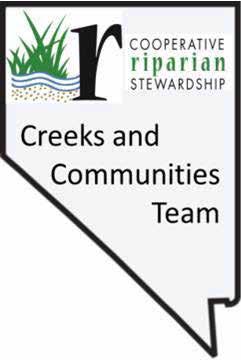
Riparian proper functioning condition (PFC) assessment uses common terms, definitions, and methods to identify opportunities for positive change from reasonable investments, enhance local management, and solve problems by people most affected. Integrated Riparian Management uses PFC assessment to prioritize needs for adaptive management with monitoring for riparian objectives and strategies. Trainings are available to landowners, Federal, State, and local agency personnel, tribes, industry, conservation interests, and others. Instructors are from Nevada Creeks and Communities Team. There is no cost for classes.
PFC Assessment for Integrated Riparian Management
July 11-14, Rafter-7 Ranch, 92 East Walker Rd. Yerington, NV. Request a reservation
PFC Assessment for Integrated Riparian Management
July 18-21, Alturas, CA. Modoc National Forest, 225 West 8th St Request a reservation
PFC Assessment for Integrated Riparian Management
September 19-21, Elko, NV. Ramada/Stockman’s, 340 Commercial St Request a reservation
You are welcome for the parts of the class you need or want (1-4 days).
Day-1 | 8:00 Registration, 8:15 AM start
Inside or Zoom for PFC instruction
Day-2 | 8:00 AM start – Outside or Zoom for PFC Assessments
Day-3 | 8:00 AM start – Inside or Zoom for Integrated Riparian Mgmt
Day-3 | PM and Day 4 – Outside or Zoom for assessing additional riparian areas. Zoom class will feature optional participant-provided case studies - PFC assessments or integrated riparian management assessment, priorities, objectives, management, monitoring, or adapting management for specific locations
Cottonwood Ranch Riparian/Creek Workshop
How to See a Creek, Tools for Improving Creek Functions, and Creating Your Story (How to show the improvements made) June 6-8, Cottonwood Guest Ranch, HC 62 Box 1300, O'Neil Route, Wells, Nevada, www.cottonwoodguestranch.com (775) 472-0222
PFC Assessment and/or Integrated Riparian Management
Coaching field sessions are available for small groups such as ID or collaborative teams beginning in May.
For PFC class signup or questions, contact: Sherman Swanson, 775-233-622, swanson@unr.edu with name, affiliation, address, phone, email, interest, discipline, role or area of expertise.
For reference materials go to:
www.tinyurl.com/NevadaBox AND www.blm.gov/learn/blm-library/ agency-publications/technical-references - Be sure to scroll down the page and expand the riparian area management section.
There will also be a Riparian Multiple Indicator Monitoring Class in Winnemucca, Nevada on June 26-30. Please contact Mark Gonzalez at mark_gonzalez@blm.gov or Steve Smith at sjsmith@blm.gov to register.
Riparian functions keep water on the land longer, reduce flood and drought effects, improve water quality, enhance forage and habitats, and focus monitoring objectives and strategies for integrated management.
Republican Sen. Mike Crapo of Idaho and Sen. Kyrsten Sinema of Arizona, an
The Progressive Rancher www.progressiverancher.com MAY - JUNE 2023 31
The change in agriculture today is just a glimpse of what lies ahead. It’s why, more than ever, we are committed to being the partner you can trust, who understands your needs and delivers value to help you achieve your goals.



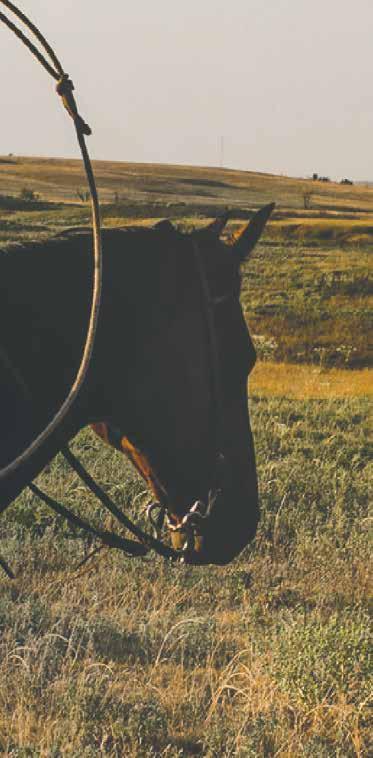
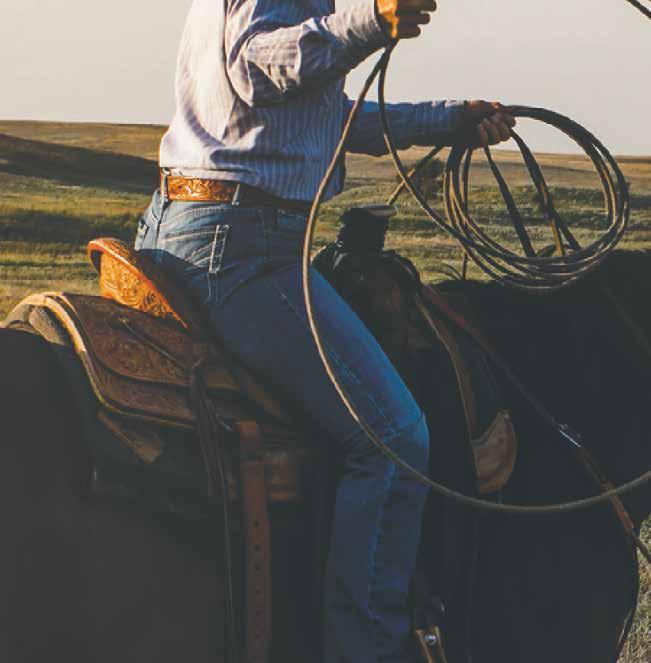

Wherever agriculture goes, we’ll be there, alongside you, as you lead the way.




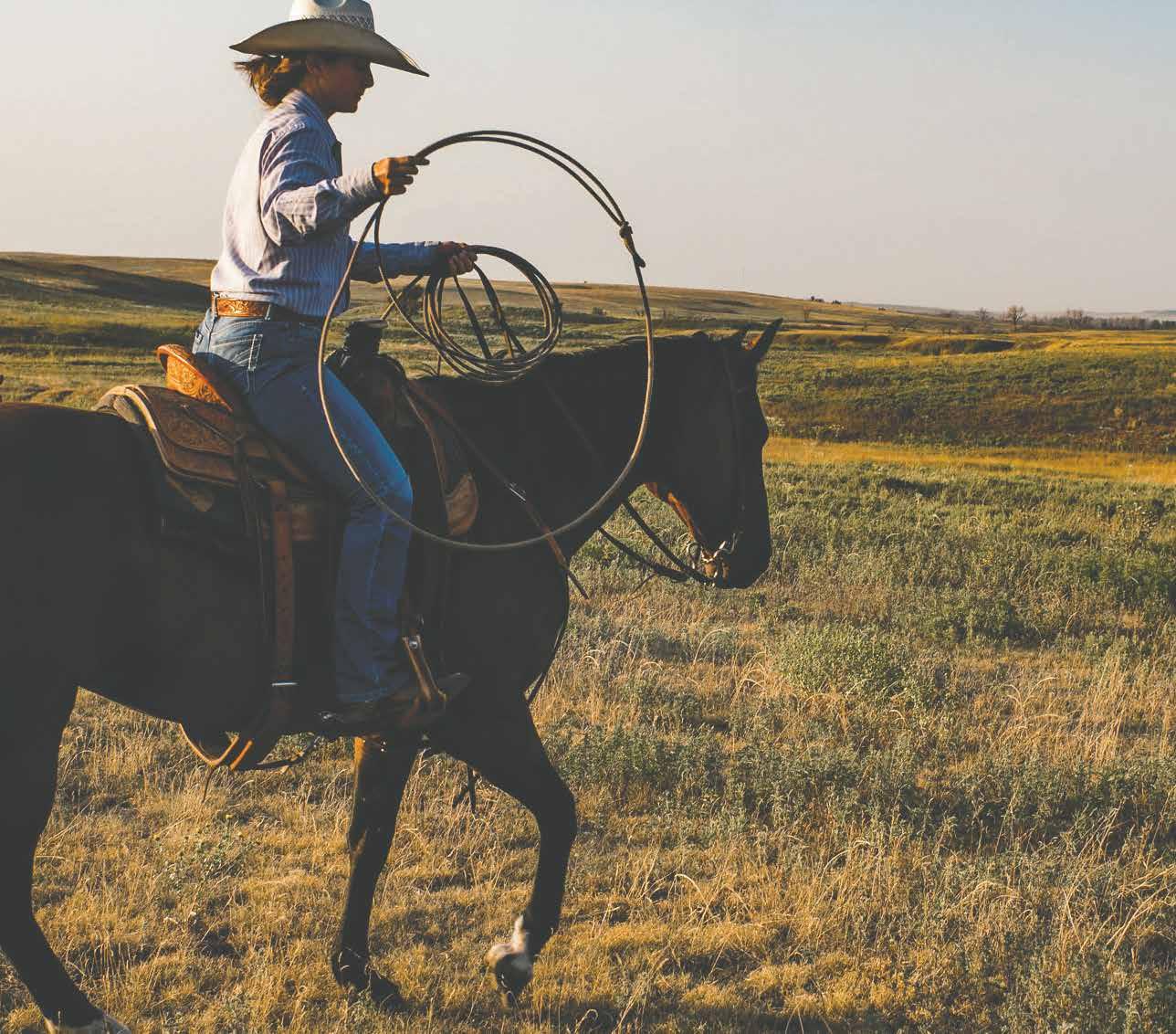
COMMITTED TO SERVING YOUR NEEDS. Visit agloan.com/growyourfuture A Part of the Farm Credit System. Equal Opportunity Lender. Your future grows here SCAN ME YOUR FUTURE GROWS HERE. The Progressive Rancher www.progressiverancher.com 32 MAY - JUNE 2023
At 80, Local Horsewoman Becomes
Nevada Horseman Hall of Famer
by Nancy Chapman, The Fallon Post
Barbara Hodges was honored with being inducted into the Nevada Horsemen’s Hall of Fame, awarded in February 2023, as well as celebrating her 80th birthday the same evening. Other distinguished honorees from previous years of this award were Bobby Ingersoll, Wilma Hybarger, and Wanda Cagalari to mention only a few.

Barbara has been a friend and mentor to many over the years. She could always see a good prospect in an up-and-coming rider. Some of her more distinguished mentees are Darrel Norcutt, Flint Lee, and Dave Thacker. All have gone on and built great training facilities and have won the reining cow horse’s most prestigious awards. But only after Barbara had paved the way with her tireless dedication to the cow horse profession in the National Reined Cow House Association, the American Quarter Horse Association, and the American Paint Horse Association.
She began training around 20 and went pro in the1960s. Together with Como Chex, she began a showing career in the early 1980s, starting with the Reno Snaffle Bit Women’s class, winning fifth place, all while raising two children Ross Hodges and Robin Hodges. She and her partner Jan Smith purchased the Sliding Sisters Ranch in 1989. This is where Barbara would work training and preparing for reining, cutting, and cow horse shows, and now ranch riding horses.
In the late 1990s, she won the California Futurity and Derby Reining in Rancho Murietta riding Como Chex Hobbit. Barbara was the AQHA World Show Finalist in Oklahoma in 1992 and 1993 in the cow horse event, again aboard Como Chex. She was the first woman to win the Elko County Fair Snaffle Bit Class in 1978 and was the only woman to compete that year, opening many doors for women. Barbara won The Woman’s Bridle Class 3 years in a row. She went on to win one year on Como Chex as a sixyear-old, then his sister Marcy Doc as a 5-year-old the next year, and finally Chexotic, Como Chex’s daughter as a four-year-old in consecutive order. Other events she participated in at Elko were the Team Sorting winning two consecutive years with the Kenny and Flint Lee. She also enjoyed Co-Ed Team Branding. Among other shows was Fallon’s own Fallon Stockhorse Spectacular, which she showed in the reining and cow horse where she won often.
In 2019 Barbara won in Idaho at the Idaho Reined Cow Horse Association riding Miss Cut N Chex placing 1st in the Limited Bridle Open Cow Horse and 5th place in the Open Bridle Horse class. Each of these events takes a very specially trained horse which is what Barbara has done for many years.
Barbara also operated a very successful breeding program. She farms her ground and keeps cattle on hand for training purposes and lessons for clients.
Barbara is semi-retired now. She enjoys training and showing Ranch Riding horses. She is always found in her arena helping non-pro clients and always at the RHAN shows or APHA helping and encouraging fellow competitors.
by Karen Budd-Falen | Opinion Editorial
Are We Being “Planned” Off Our BLM Lands?
Remember the huge backlash in 2017 over the Bureau of Land Management’s (BLM) “Planning 2.0 regulations?” One of the major concerns was that the BLM could use those planning rules to eliminate all use by creating ambiguous standards for multiple use that were left to absolute agency discretion. There was so much outcry that Congress passed a bill (under the Congressional Review Act), which the President signed, repealing the BLM Planning 2.0 regulations.
Rather than learning its lesson, the BLM is at it again. While the BLM claims the 2023 proposed planning regulations are needed for “conservation and landscape health,” the proposed rules are no more than a thinly veiled elimination of economic use on BLM lands. While no one who relies on the use of the BLM lands wants to see environmental degradation, the proposed rules do nothing more than:

1. Create a whole new “multiple use” called “conservation use” which has no basis in statute (can you say “major questions doctrine” which the Supreme Court has used to strike down agency regulations that are outside their statutory authority);
2. Allow radical environmental groups to nominate and acquire “conservation leases” on BLM multiple use lands for purposes like “restoring public lands,” “providing mitigation for a ‘particular action’” or ensuring “resilient public lands” (whatever that means);
3. Eliminate valid existing rights that are not “compatible” with a conservation lease. Instead, the proposed rule states that the only use guaranteed on a conservation lease is “casual use,” which is defined as a noneconomic use;
4. Require the BLM to take the “precautionary approach” when authorizing land uses that may impair “ecosystem resilience.” Given the proposed planning rule is based, in part, on Biden’s 30 x 30 and climate change
Executive Orders (EO), doesn’t everything impair “ecosystem resilience” and contribute to climate change? Remember that Biden’s 30 x 30 EO opines that only land in its “natural state” meets the 30 x 30 requirements. Since this administration believes that ecosystem resilience is necessary to defeat climate change and only land in its natural state will meet the country’s climate goals, I am assuming that the protection of the natural state means no use of multiple use lands;
5. Extort money from those who are wealthy enough to pay “third party mitigation fund holders.” This seems like another easy way to send funds to radical environmentalist organizations with little to no public review;
6. Further slow down the permitting process for activities on BLM lands. Currently every metric shows that the BLM is woefully behind on completing term grazing permit renewals because of the monitoring and paperwork that has to be completed including completion of the Fundamentals of Land Health. Now imagine the backlog the BLM will have for its permit review, even for valid existing rights, as every use on the BLM lands has to go through a Fundamentals of Land Health review prior to authorization. Use of multiple use lands won’t stop because of concern over legitimate environmental harm; it will stop because the BLM simply does not have the money, manpower or time to complete the analysis (which appears to be the goal anyway).
The proposed rules also don’t mention any of the other statutes mandating use of BLM lands such as the Taylor Grazing Act, the Mineral Leasing Act and the 1872 Mining Law. While there is a long way to go before these proposed planning regulations are completed, looking at my crystal ball, I see a Congressional Review Act battle all over again. I just hope it will not be too late to save the family rancher who relies on the use of his grazing permit for his livelihood.
The Progressive Rancher www.progressiverancher.com MAY - JUNE 2023 33
A

few of our favorite scenes from the
2023 Churchill County Junior Livestock Show & Sale
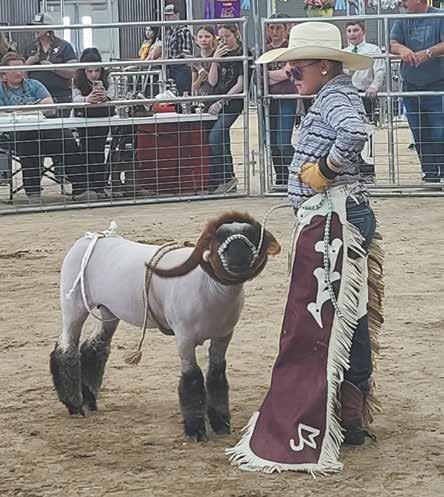
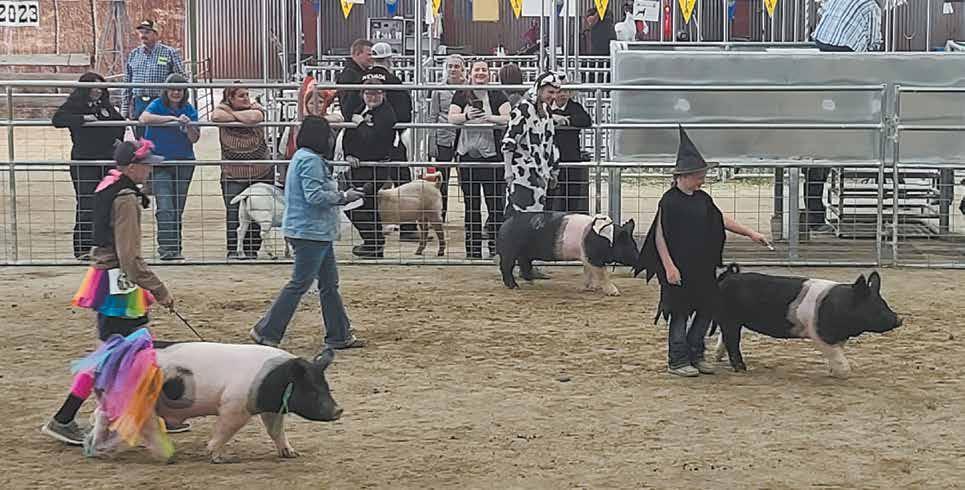
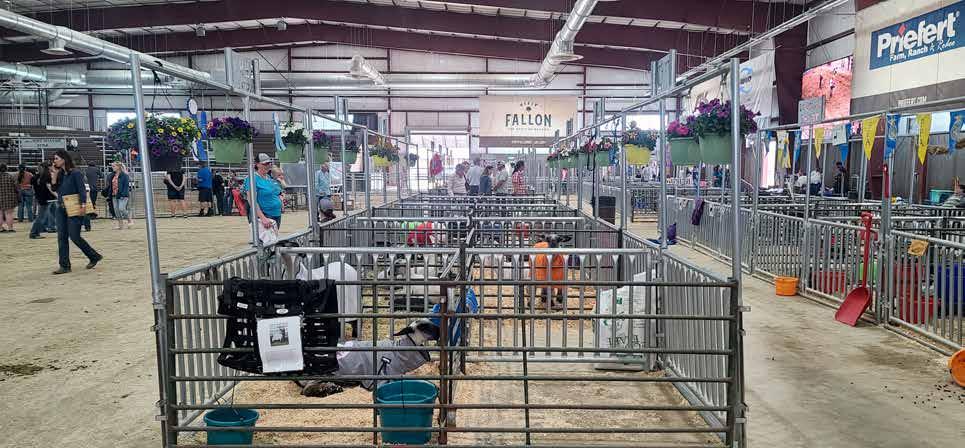

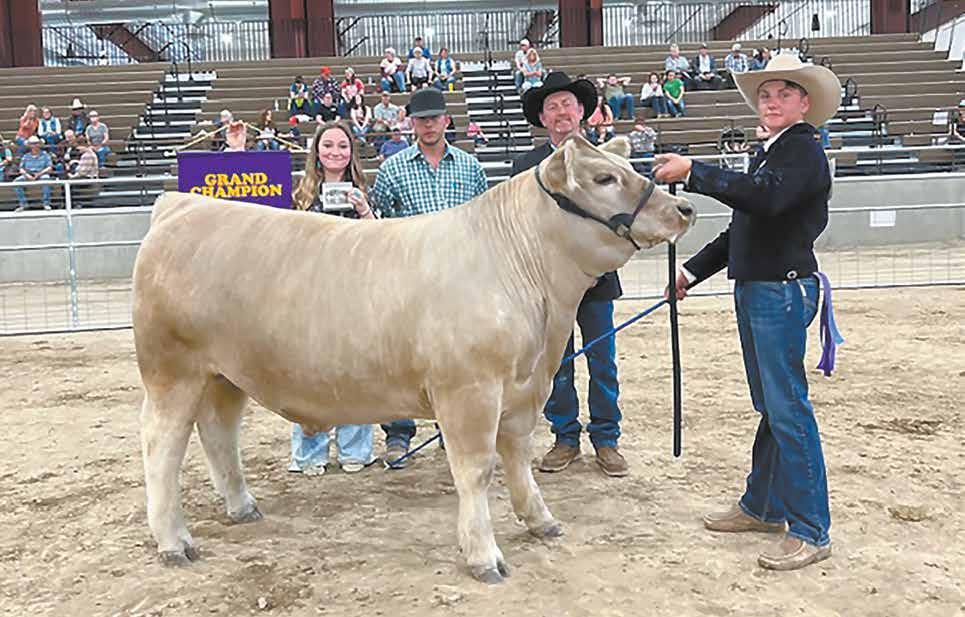
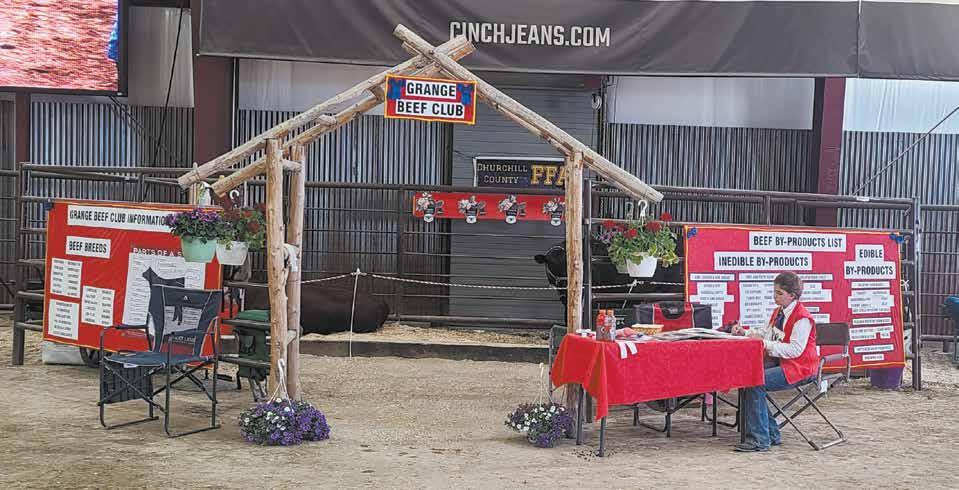
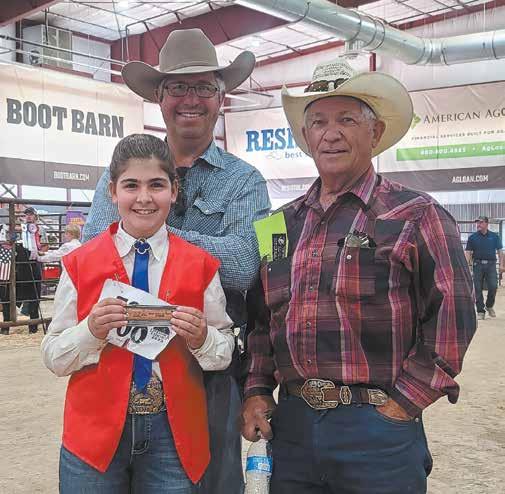
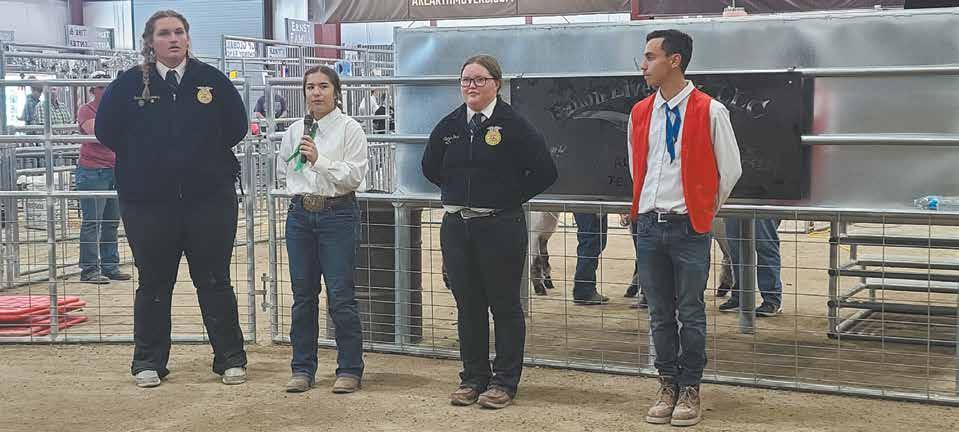
April 27-29, 2023
Rafter 3C Arena / 3C Event Complex
1) 4H FFA Grange Youth Organizations
2) Rio Segura Grand Champion Steer
3) The Alegera family - 3 generations showing beef steers
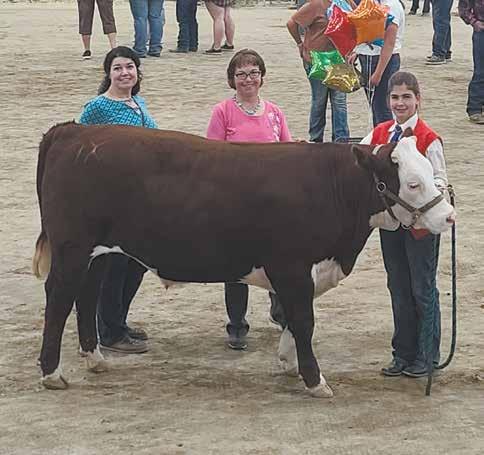
The Progressive Rancher www.progressiverancher.com 34 MAY - JUNE 2023
Local Cowgirl Tylie Norcutt Reins in Huge Win
Tylie Norcutt, a graduating senior at Oasis Academy, has forgone high school rodeo this year to blaze her trail to bigger and better things. And what a trail it is.

After ten days in Ft. Worth at the Celebration of Champions, the National Reined Cow Horse Association World’s Greatest Horseman competition last week, 17-year-old Tylie walked away with a most prestigious award, the World’s Greatest Youth Horseman.

For those unfamiliar with the reined cow horse world, it is a Western riding competition that tests the horse and rider’s combined ability when working cattle. Competitors are judged on accuracy, timing, and responsiveness, generally, the pair endeavor to demonstrate advanced horseman skills while maneuvering together easily and gracefully.
Tylie showed off her talent in four events: roping (steer stopping), fence work, herd work, and reining. Her events partner is a 10-year-old reining cow horse called Kenny, more formally
An Interview with Tylie Norcutt
known as Soulas Hickory Star. According to Tylie, Kenny became part of the family eight years ago when he began his training with expert horseman Darrel Norcutt, more informally known as Dad. Tylie took the reins and began competing with Kenny less than two years ago, a match made in reining cow horse heaven.
Although confident in all areas she competed in, Tylie confessed the roping event was the most challenging. “I shouldn’t have been nervous, but I was a little. Probably because it was the first event I was in.” This was her first time at the Celebration of Champions and her first major event since last fall. Nervous or not, Tylie excelled in the arena.
All the while, “She never stopped smiling and kept the best attitude,” said Mom Cari Norcutt. Tylie will test her and Kenny’s skills again at the Stallion Stakes in Las Vegas next month, and if Ft. Worth is any indicator, competitors beware. Dynamite comes in small packages.
by Leanna Lehman | The Fallon Post
I arrived in Texas at the beginning of the week for the Celebration of Champions NRCHA cow horse show. I was entered in the limited non-pro bridle and the World's Greatest Youth Horseman on my horse, Soulas Hickory Star or as I like to call him, Kenny. The Non Pro was at the beginning of the week and a couple days before the Jr World’s Greatest started. I tried to use the non-pro as a practice for the world's greatest. I mainly just wanted to go in there and make a run to see what I need to focus on in my rein and cow work. After, I had days before the Youth World’s Greatest started, and the nerves kept building up each day. My first event was Steer Stopping. I was way more nervous than I ever thought I'd be, but I ended up scoring a 148 and tying for first place. I was extremely relieved after it was over and rein work and cow work were my next events. I felt more confident now that I could move on to an event my horse was trained to do, but that didn’t stop me from thinking that I was somehow going to mess it up. The rein work for the most part went as planned. I’m not gonna lie, we had a few bobbles, but it was nothing that was gonna take me out of the running. I had pretty good cow work to go with it and was going into the herd work still sitting first. Herd work has never been my strongest event on any horse, and it’s definitely not Kenny’s strongest event. I knew that if I had clean cuts and kept it smooth, then I would at least mark a decent score to keep me in the running. I was relieved to see that I marked much higher than I expected with a 144.5. Once the herd work was completed, I knew that I was going into the finals sitting first and a point and a half above 2nd. The finals were the night after herd work and I had all day to mentally prepare myself for it, which was basically me trying to calm myself down the whole day because I was so nervous. I was still thinking that I was somehow going to mess it up and I had no chance of actually winning the youth world’s greatest, but I still had to go show my horse regardless. I probably got on my horse way too early, especially since I drew up 2nd to last, but it gave me time to talk to some of the open guys who have shown in this arena before. I knew that going down the fence in the colosseum is way different than anywhere else. The arena is a bit smaller than most and shaped more oval. This makes it harder to get in boxing and bringing the cow around the corner. The cows also can be more pushy, especially when going into your second fence turn. I was able to get advice about what it’s like to show in this arena from a couple of the open guys who were showing in Fort Worth. Before I went, I was just trying to repeat as much as I could remember to myself and hopefully get to use most of their advice when I showed. Once the youth started, I was towards the end, so I was able to watch almost everyone else in the finals. By the time it was my turn to show, I knew all I needed to do was make a good solid run, but there is no safetying up in the fence work. Based on what I’ve heard about the arena, and knowing the capabilities of my horse, I knew that going for it wasn’t going to be a problem. I tried to make the best run I could and ended up with a 148 down the fence. Showing in that arena felt like a rock concert. The stands were completely packed and I could hear everybody yelling. It was by far one of the greatest experiences of my life and I am beyond grateful for the opportunity of even getting to go to Fort Worth, Texas and show in the 2023 World’s Greatest Youth Horseman.
Portrait of Tylie Norcutt by Taryn Lenon Photography, Fallon
First photo above: Tylie and Kenny at Ft. Worth
Photo courtesy Cari Norcutt
The Progressive Rancher www.progressiverancher.com MAY - JUNE 2023 35
Resources available for farmers and ranchers affected by winter storms and flooding
Contact local FSA office to begin process
The Nevada Department of Agriculture (NDA) has been working with the U.S. Department of Agriculture (USDA) Farm Service Agency (FSA) to find resources and assistance for farmers and ranchers impacted by winter weather and flooding.

Producers should report loss of livestock or infrastructure to their local FSA office to begin the process.
“We know it has been a tough winter and as the weather warms concerns are shifting from snow and cold temperatures to flooding,” said NDA Director J.J. Goicoechea. “We hope that this is the beginning of some relief for our farming and ranching communities.”
Any producer who has experienced any level of loss (loss to livestock or crop, structure failure, challenges accessing or purchasing feed, etc.) is encouraged to report to their local FSA offices. For any losses going forward, it should be reported within 30 days. Reports can be made via phone call, email, or by walking into a local office.
“Again, I want to emphasize our thanks to our agriculture industry for their dedication to their livestock and operations,” said Director Goicoechea.
The NDA has provided more information on disaster assistance available to producers on their website at agri.nv.gov. Find contact and location information for the nearest FSA office at farmers.gov/ service-center-locator.
DISASTER ASSISTANCE PROGRAMS
The United States Department of Agriculture (USDA) Farm Service Agency (FSA) Disaster Assistance programs are available for those impacted by adverse weather including flooding, drought, and other conditions which might impact infrastructure and/or access to animals. The FSA offers Disaster Assistance segmented by production type, each with specific eligibility requirements. Determining which program is most appropriate for a producer is the first step. Producers are encouraged to contact their local FSA office to begin the process. The FSA has local offices and agents throughout Nevada to help producers with their specific needs. In addition to FSA assistance, relief programs and resources may also be available through the USDA Risk Management Agency (RMA), Natural Resource and Conservation Service (NRCS), the Nevada Department of Agriculture (NDA), and other organizations. Below is general information and guidance on relief programs and resources. The USDA Disaster Assistance Tool is helpful in navigating the various programs that can assist during a disaster. The tool can be found at: farmers.gov/protection-recovery/disaster-tool. Producers facing resource gaps or challenges, are encouraged to reach out to the NDA at NDAEmergency@agri.nv.gov to find solutions.
FSA DISASTER ASSISTANCE PROGRAMS
The Emergency Assistance for Livestock, Honeybees and Farm-raised Fish (ELAP) provides assistance for eligible producers who have experienced livestock feed losses due to natural disasters such as adverse weather and drought. Natural disasters on federally managed land are not eligible and must occur on private lands for ELAP to cover losses. There is additional assistance provided for feed transportation for impacted ranchers. Under the revised policy for feed transportation cost assistance, eligible ranchers will be reimbursed 60% of feed transportation costs above what would have been incurred in a normal year. Producers qualifying as underserved (socially disadvantaged, limited resource, beginning or military veteran) will be reimbursed 90% of the feed transportation cost above what would have been incurred in a normal year.
There is also assistance available for water transportation, but not for the cost of water. This program can provide eligible producers with compensation for expenses associated with transporting water to livestock located in counties with at least eight consecutive weeks of D2 Severe Drought, D3 Extreme Drought or greater as defined by the US Drought Monitor.
Examples of covered ELAP losses: Grazing losses, feed purchased above normal pricing or quantity, damaged feed, snow removal expenses, feed transportation, livestock transportation, etc.
The FSA requests a notice of loss within 30 calendar days* of when the loss is first apparent. Deadline to submit application for payment is Jan. 30, 2024.
The Emergency Conservation Program (ECP) is available to help repair damage to farmlands caused by natural disasters and adverse weather, and to assist with approved methods for water conservation during periods of severe drought. All counties in Nevada are currently eligible due to extensions of the USDA Secretarial Disaster Designation as of March 2023. The eligibility period will continue until the disaster designation is lifted.
The FSA County Committee will inspect the damaged land to determine eligibility for ECP. For land to qualify for ECP funds, the damage from the natural disaster or severe drought must create new conservation problems that, if not addressed, would:
• Further damage the land;
• Significantly affect the land’s productive capacity;
• Represent damage from a natural disaster unusual for the area (an exception to this is damage from wind erosion); and/or
• Be too costly to repair without Federal assistance in order to return the land to agricultural production. Conservation problems that existed before the disaster or severe drought are ineligible for ECP assistance. Technical assistance to address agriculture land conservation problems may also be provided by the NRCS.
Examples of covered ECP losses: Damage caused to farmlands by natural disasters and adverse weather such as winter storms, flooding drought, etc.
Disaster impacts should be reported to the FSA as soon as impacts are apparent. Application sign-up period varies by county. Contact your local FSA office for more information.
Last updated: 4/25/2023 agri.nv.gov
Emergency Farm Loans are also available for producers in need of emergency funding and provide recovery from production and physical losses experienced due to drought, flooding, adverse weather and other natural disasters. In order to be eligible, a producer must own or operate land located in a county with a Disaster Designation and have experienced at least 30% loss in crop production or physical loss in livestock. FSA loans are different from private lenders and require borrowers to operate with a farm plan developed and agreed upon with their local FSA office.
The use of the Emergency Farm Loan can cover the costs for essential family living expenses, restore or replace essential property, reorganization of farming operations, and/or pay for all or part of the production costs associated with the disaster year.
Example: Reorganizing of farming operations can mean changing enterprises, production practices, marketing methods, or other parts of the farm business to promote recovery from the disaster and reduce the potential impact of any future disasters. A producer that had severe drought or flood damage to a field that caused a loss of 30% or more in production yield can shift from row crop to vegetable production. They could also purchase grain drying and storage equipment to facilitate better marketing. Any operational changes are acceptable if a realistic farm operating plan indicates the changes will improve the financial viability of the farm.
Page 1 NDA
www.progressiverancher.com 36 MAY - JUNE 2023
DISASTER ASSISTANCE PROGAMS
FSA DISASTER ASSISTANCE PROGRAMS
The Livestock Forage Disaster Program (LFP) is available for drought-affected land planted for grazing that has suffered a loss from natural disaster including adverse weather or drought. All counties in Nevada are currently eligible due to the USDA Secretarial Disaster Designation extensions as of March 2023 and will continue until the disaster designation is lifted.
The LFP provides payments to:
• Eligible livestock owners and contract growers who have covered livestock AND
• Who are also producers of grazed forage crop acreage (native and improved pasture land with permanent vegetative cover or certain crops planted specifically for grazing) that have suffered a loss of grazed forage due to a qualifying drought during the normal grazing period for the county.
Example: A cow-calf producer experienced drought and/or fire on their land, causing loss of feed and forage areas. Adverse weather conditions compounded the problem making it difficult to buy and distribute additional feed and the producer decided to sell the cow-calf pairs in February. They owned the land and the cows in the 60 days leading up to the weather event. They have sales receipts for the pairs as commercial purpose livestock. They filed an acreage report when they realized that they are eligible for an LFP payment if they didn’t already have one on file. Assuming they met all the requirements they would receive a payment. The LFP payment = head x payment rate per head x payment months.
Check with your local FSA office to see if your county is eligible. The deadline to submit application for payment is Jan. 30, 2024.
The Noninsured Crop Disaster Assistance Program (NAP) is available to cover losses of hay and grasses intended for food or livestock and that aren’t eligible for private crop insurance or insurance provided through RMA. NAP insurance must have already been purchased for the 2023 year to be eligible. The NAP application period is open for coverage of future grazing season. There is no retroactive coverage, so producers will want to apply as soon as they can. Applications can be completed at their local FSA office.
The damaging weather must occur during the coverage period, before or during harvest, and must directly affect eligible crop(s).
The FSA requests a notice of loss within 72 hours for value loss crops or within 15 days* of when the loss is first apparent for all other crops. Deadline to submit application for payment is no later than 60 calendar days* after the coverage period ends for any NAP covered and insured crop.
NDA HELP AND RESOURCES
The Livestock Indemnity Program (LIP) provides assistance to livestock owners or contract growers for livestock deaths in excess of normal mortality rates caused by eligible loss conditions, including adverse weather. In addition, LIP provides assistance to eligible livestock owners that must sell livestock at a reduced price because of an injury from an eligible loss condition.
Examples of covered LIP losses: Livestock deaths in excess of normal mortality as a direct result of an eligible loss condition such as winter storms, freezing temperatures, flooding, etc.

The FSA requests a notice of loss within 30 calendar days* of when the loss is first apparent. Deadline to submit application for payment is Feb. 29, 2024.
Some of the resources available to producers are managed by USDA agencies—the FSA, the NRCS and the RMA. Understanding the disaster designations and the timelines for submitting impact reports can also be confusing when unfamiliar with disaster assistance programs. Additionally, drought programs available from NRCS can be proactive instead of reactive which can greatly reduce drought impacts from future drought events. Knowing the difference can save producers a lot of time depending on their needs. Producers that are having difficulty navigating the resources available to them can reach out to NDAEmergency@agri.nv.gov.
The USDA Disaster Assistance Tool is helpful in navigating the programs that can assist during a disaster. The tool can be found at farmers.gov/protection-recovery/disaster-tool
CONTACT
Resources are continually being developed as producer needs evolve. The USDA farmers.gov website and your local FSA office will have the most up-todate resources available.
Producers unsure of where to start, needing assistance determining which programs are best for them or looking to plan ahead are encouraged to contact:
Nevada Department of Agriculture
NDAEmergency@agri.nv.gov agri.nv.gov
*FSA policy asks producers to report the notice of loss within 30 calendar days of when the loss is first apparent. However, in some cases there is authority to approve any eligible losses that are submitted beyond that. Some producers may be reporting losses that are applicable to multiple programs or reporting additional losses. We just ask that producers report as soon as they are able so we may begin offering assistance.
*FSA policy asks producers to report the notice of loss within 30 calendar days of when the loss is first apparent. However, in some cases there is authority to approve any eligible losses that are submitted beyond that. Some producers may be reporting losses that are applicable to multiple programs or reporting additional losses. We just ask that producers report as soon as they are able so we may begin offering assistance. **Additionally, livestock numbers and data related to expenses incurred are not immediately needed when reporting losses. This can come at a later time, but prior to the application for payment deadline.
**Additionally, livestock numbers and data related to expenses incurred are not immediately needed when reporting losses. This can come at a later time, but prior to the application for payment deadline.
Last updated: 4/25/2023 agri.nv.gov Page 2
NDA
The Progressive Rancher www.progressiverancher.com MAY - JUNE 2023 37
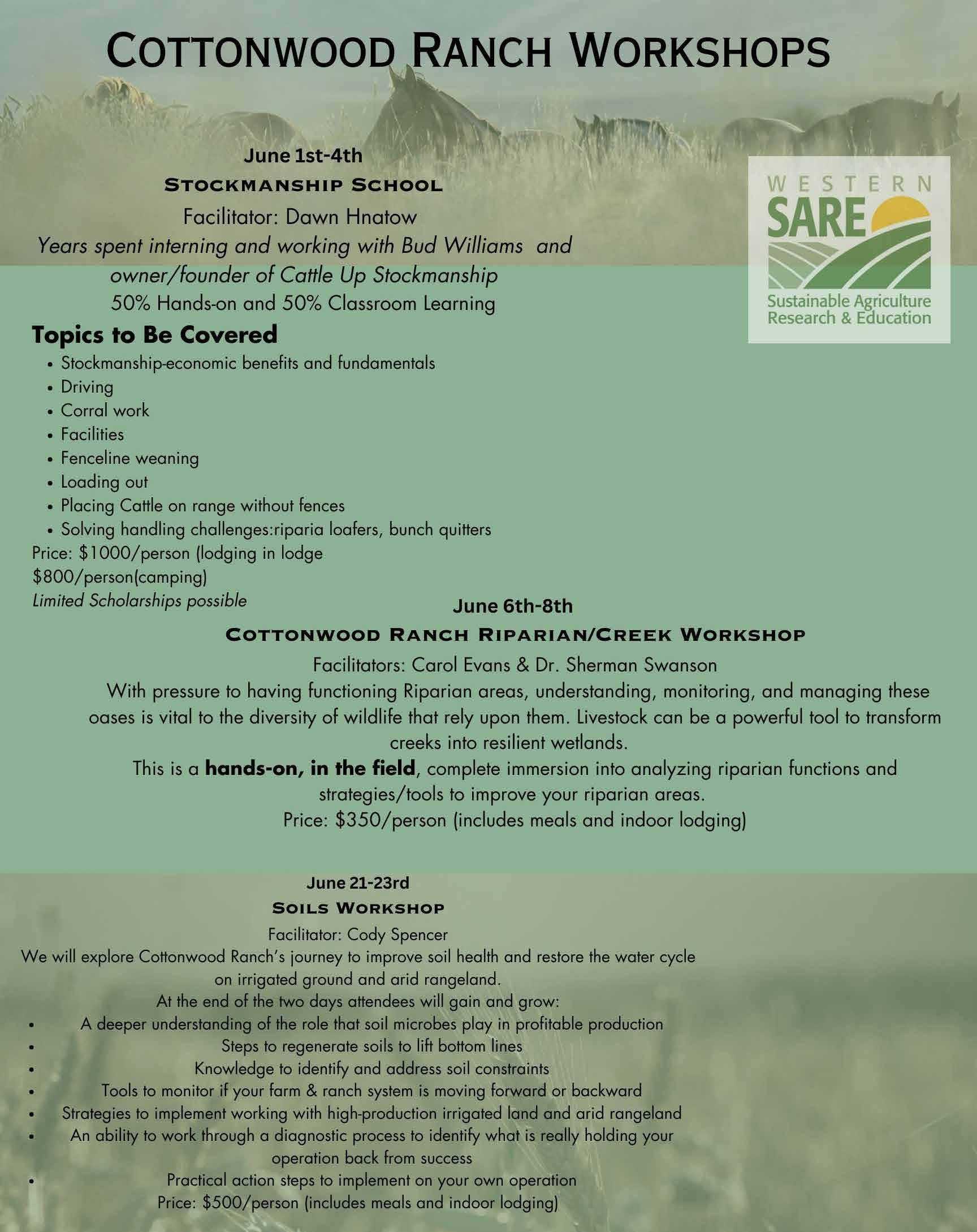
The Progressive Rancher www.progressiverancher.com 38 MAY - JUNE 2023

The Progressive Rancher www.progressiverancher.com MAY - JUNE 2023 39

Presort Standard U.S. Postage PAID Tooele , UT Permit # 40


































 By Morgan Noorda, Wells FFA chapter reporter
By Morgan Noorda, Wells FFA chapter reporter


 By Charlie D. Clements and James A. Young, Rangeland Scientists, USDA-ARS,
By Charlie D. Clements and James A. Young, Rangeland Scientists, USDA-ARS,























































